Over the past few years fire management and cultural burning have developed as a fascination in me. As a child I was always a bit of a pyro-maniac, but pairing such a Promethean yet utterly human urge with ecological management and plant cultivation reaps interesting and often unbelievable results. Don’t take it from me, but take it from indigenous people the world over. Humanity’s use (and in some cases, abuse) of fire is as old as our modern species. Carbon deposits from landscape-level burning at the hands of humans extends back at least 100,000 years and probably many more.
So why and for what were people burning? The short answer is “many reasons.” Firing dormant grasses causes them to grow back lusher and thicker, with more nutrients. Thus burning the grasslands benefits the herbivorous animals especially grazing megafauna. Firing shrubs and brambles coppices them, and they too grow back more vigorously than before, often with more shoots, longer and straighter. This makes ideal material for cordage, basketry, and fiber. And this benefits herbivorous animals, again, especially those who browse on shoots and leaves (like deer).
Fire may also act as a kind of pest control, for example by burning up the fallen leaves underneath groves of oak, chestnut, or hickory. Nut-destroying pests like Curculio weevils overwinter in this leaf litter, and as fire passes through the weevils get cooked, thus greatly reducing or eliminating their pressure the following season. In the eastern forested regions of North America, many of our hardwood trees like the oak, chestnut, and hickory have developed thick, fire-resistant bark, making insect pest management with fire not just theoretical but extremely efficient and practical, and with much historical precedent.
Fire also influences soil chemistry. Both the char (black carbon coals) and ash (white/grey mineral residue) have a pH of around 8.0, which means that repeated and regular firing of brush and vegetation has an effect on the soil like that of amending it with lime. The char component – what we call “biochar” specifically – has a high cation exchange capacity, and creates a substrate holding on to microbes, water, and minerals for centuries and even millenia. The terra preta soils of the Amazon, among the richest in the world, are an example of anthropogenic pyrolithic (i.e. fire-derived) soils.
The moderative effects over pH that char and ash cause also result in more bioavailability of the big crucial soil macronutrients like calcium and phosphorus. Calcium specifically benefits the growth and development of root and tuber structures, as well as fruiting structures and nuts. In other words, calcium makes blueberries and strawberries sweeter and more nutritious, and it makes hickory nuts and acorns bigger and tastier. Another great reason to burn. Prescribed fire is the original fertilizer.
The other virtue of fire is that by clearing away the leaves, thatch, and brush, the ground gets exposed, and this allows lots of seeds to germinate which otherwise wouldn’t get that chance, being smothered under a layer of detritus. While this is great if there are seeds you want to introduce to an area (as in ecological restoration work, or fire-stick farming), it’s also potentially a double-edged sword because you may notice a huge amount of emerging seedlings of things you didn’t expect to germinate, from seeds having lay dormant for perhaps years.
I could go on but I didn’t write this to be an essay. Instead I want to share with you through pictures some of my real-world experimentation with fire on the landscape, specifically as it relates to fire-stick farming systems. There will be other writings where I go into more depth about the nuts and bolts of fire ecologies and fire subsistence through the written word. Some good books on the subject for the time being are “Tending the Wild” by M. Kat Anderson, “The Maya Forest Garden” by Anabel Ford & Robert Nigh, “Forgotten Fires” by Omer Stewart, “Dark Emu” by Bruce Pascoe, “The Biggest Estate of Earth” by Bill Gammage, and books by Stephen J. Pyne like “Vestal Fire.”
Now for the photo journal.
Winter 2018 – Spring 2019: the first firing.
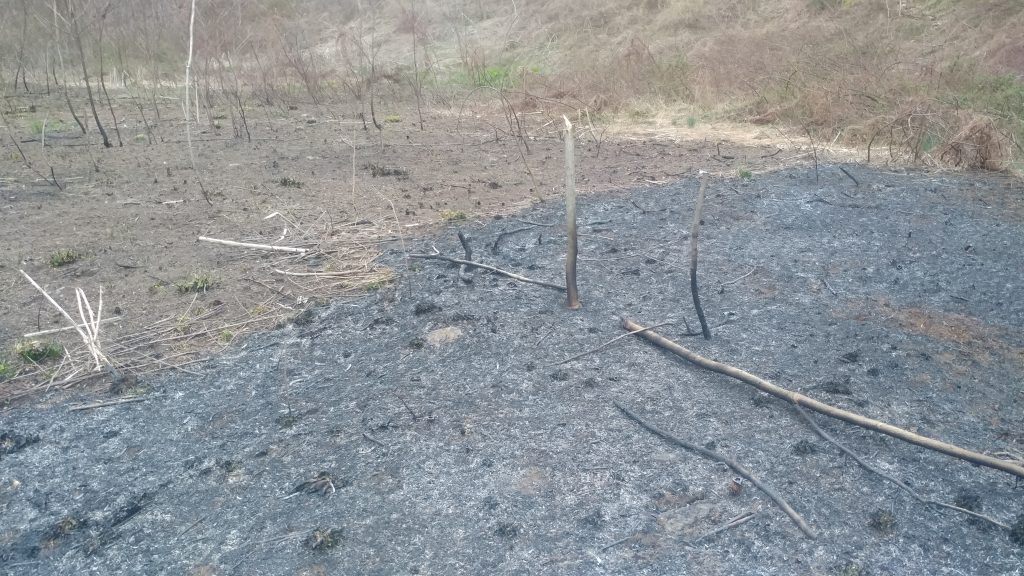
What we have here is a riparian area. This is the terrace just above a floodplain. You can’t see it in the frame, but immediately south (below the picture) runs a creek. The creek runs through a channel carved through legacy sediment about 6 feet lower than the flat terrace pictured here. The actual floodplain is about 3 feet lower than the terrace.
The great thing about riparian areas is that they are full of alluvial soils. Alluvial soils are made up of silts, sands, and organic materials which erode down from the surrounding hillsides, carried by the rain. This is what is called “loam.” The soil here is a sandy loam, ideal for lush vegetative growth.
As you may discern by the gradation in charred marks over the surface of the floodplain terrace, I burned in stages. This is the part where I have to say, “Kids, don’t try this at home.” Fire is a powerful tool but it can be dangerous when uncontrolled, and if things gets out of hand you will be held responsible.
Because the creek is a couple steps away, it is very easy to keep several buckets filled at any given moment. My other tools of the trade are work boots (for stomping the hot coals) and a long handled spade shovel for tamping out potentially problematic flames. That’s the first resort, water should really only be a last resort.
Burning the landscape sounds scary, but experienced, judicial, and artful burning looks decidedly tame. When I’m burning off brush, I’m not trying to create an enormous bonfire. Instead what I’m looking for is a small, manageable tongue of flame which is as small to the ground as possible, usually three feet high or less. If you can achieve a perfect “back-burn” with flames a few inches to a foot and half tall, congratulations. We keep the fires small and closely tended. You should be able to walk with the fire. I really like the phrase “walking with fire” to describe the burner’s learning experience. Our hazards leading to uncontrolled fire are exponentially multiplied the larger the area is we try to burn. Therefore, start small. Remember, you can always burn in stages.
When I burn there are many things I need to be aware of. One is the direction of the breeze. If there is any actual wind, especially gusty wind, it is not a day to burn. Being aware of direction of the breeze is important, because after creating my fire brakes I start the burn on the windward side of the to-be-burned area. This way if the breeze does carry the flame, it won’t carry it uncontrollably bouncing across the meadow, but will push the flame “backwards” in the direction of what’s already been burned. This is called a back-burn.
Fortunately the perception of fire is changing these days and smoky the bear is taking a backseat to new regulations allowing prescribed fire, open brush burns, etc., by private individuals and homeowners. Before you begin burning on a property you will want to check in with your local fire dispatch and notify them of your intentions. Call them before you start burning, and call them again when you’re done to let them know it is out. Always have a buddy with you, especially if you’re new to this. Look into your local prescribed fire council, if you have one, for resources, tips, and even certification in the process.
Also note, the area I burned was already fairly open before I ever came and burned it, and that’s partly why I chose the site. This is slash-and-burn without so much slash. If this began instead as forest clearance through full slash-and-burn, the emerging plant composition would initially have fewer herbaceous heliophiles (sun-loving plants).
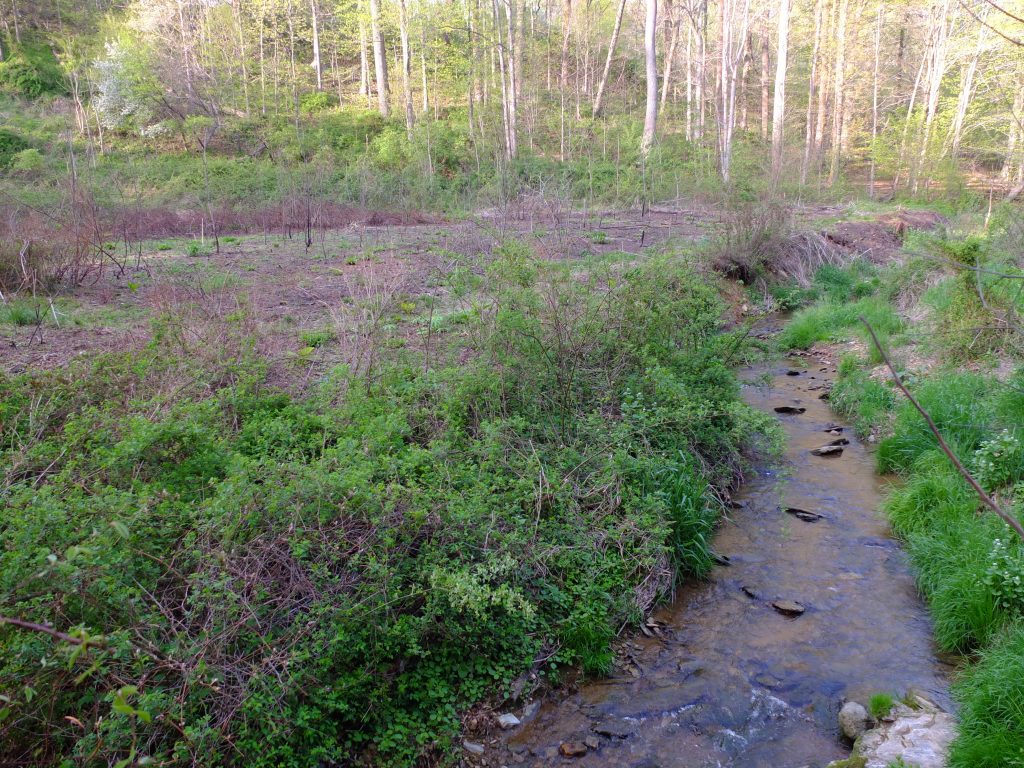
Here’s a picture of the creek flowing towards the west. This picture comes a few weeks after burning, as the land has begun its greening in early spring.
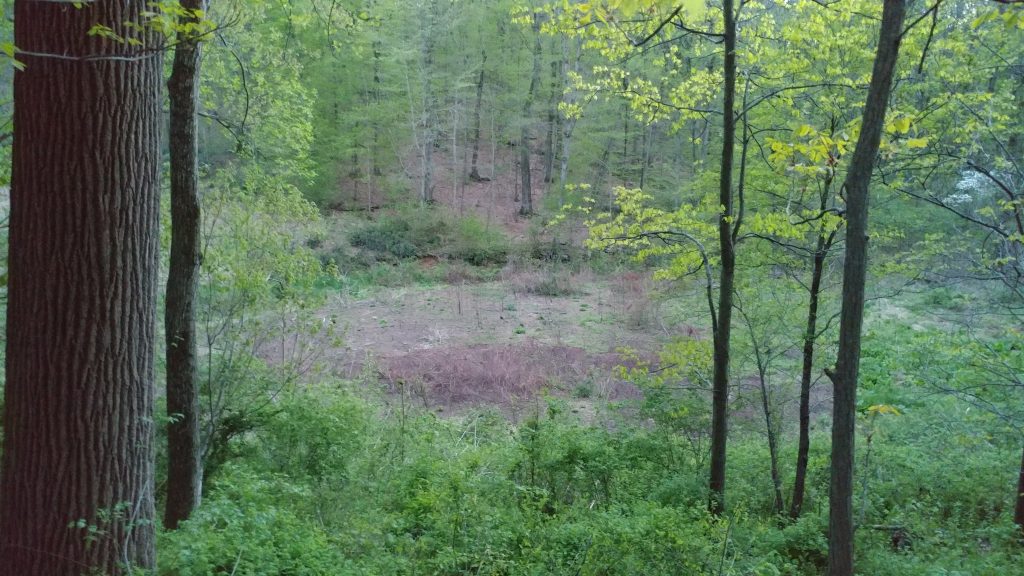
Here’s a look at the burned area from the hillsides perched above the floodplain to the northeast.
The next series of pictures document the emergence of plant life as the green people wake up throughout the spring and into the summer. Unless otherwise indicated, all these plants were already present natively in the seed bank. I will also go on to add a few species, which I will describe when I get there.
What emerges in the spring 2019 following the first burn: wild pink (Silene caroliniana), sessile bellwort (Uvularia sessilifolia), dwarf ginseng (Panax trifolius), mayapple (Podophyllum peltatum), Japanese spiraea (Spiraea japonica), Canada garlic (Allium canadense), Turk’s cap lily (Lilium superbum), wild yam (Dioscorea villosa), bloodroot (Sanguinaria canadensis), jack-in-the-pulpit (Arisaema triphylla), leaves of sochan (Rudbeckia laciniata), mile-a-minute seedlings (Polygonum perfoliatum), blackberry (Rubus pensylvanica), cinnamon fern (Osmundastrum cinnamomeum), meadow-rue (Thalictrum dioicum), and graminoids and grasses such as foxtails (Setaria sp.), deer-tongue grass (Dichanthelium clandestinum), and some unidentified sedges (Carex spp.). In a mucky marshy area nearby wapato also emerges (Sagittaria latifolia).
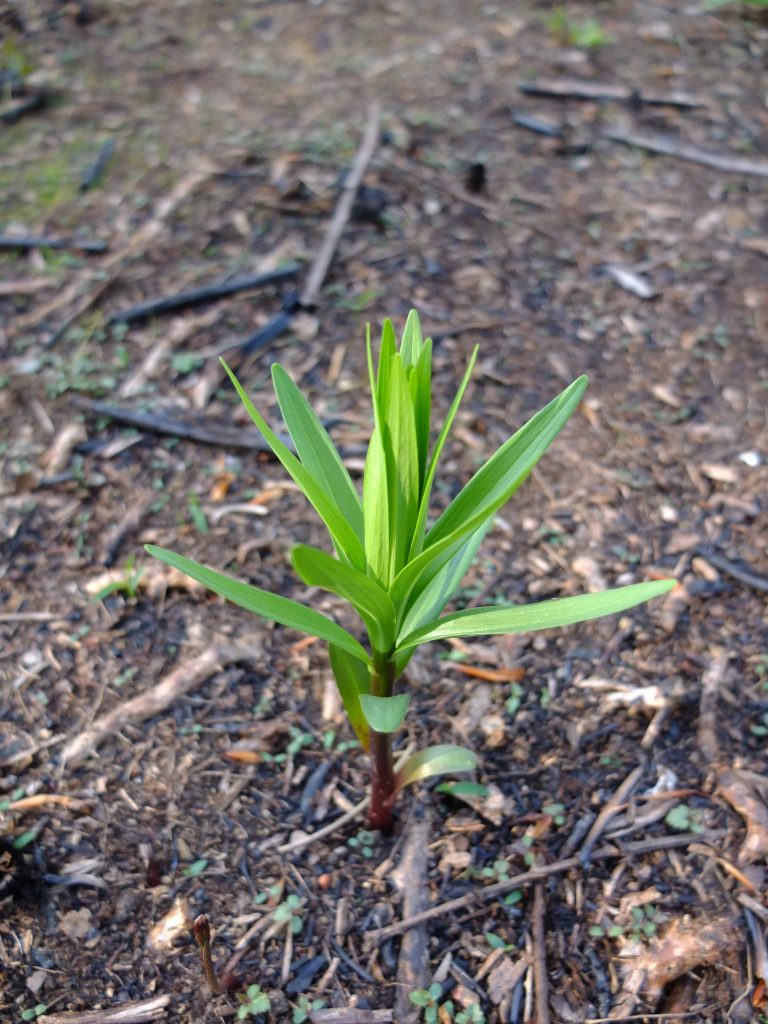
Turk’s cap lily emerging 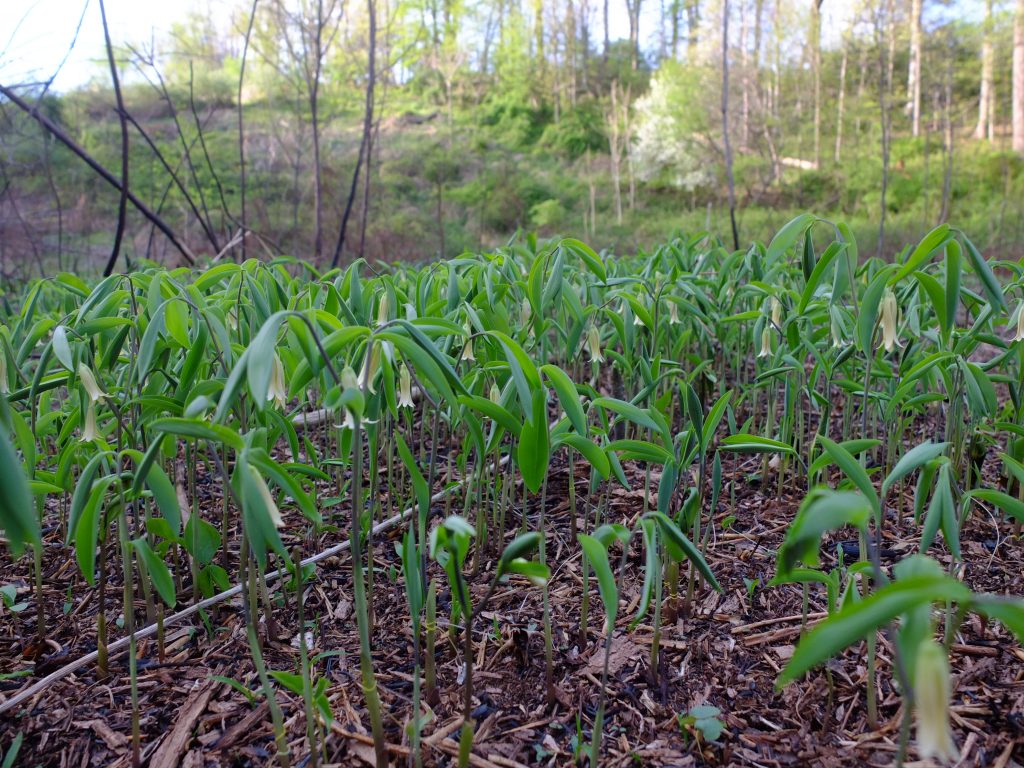
Sessile bellwort colony happily in flower 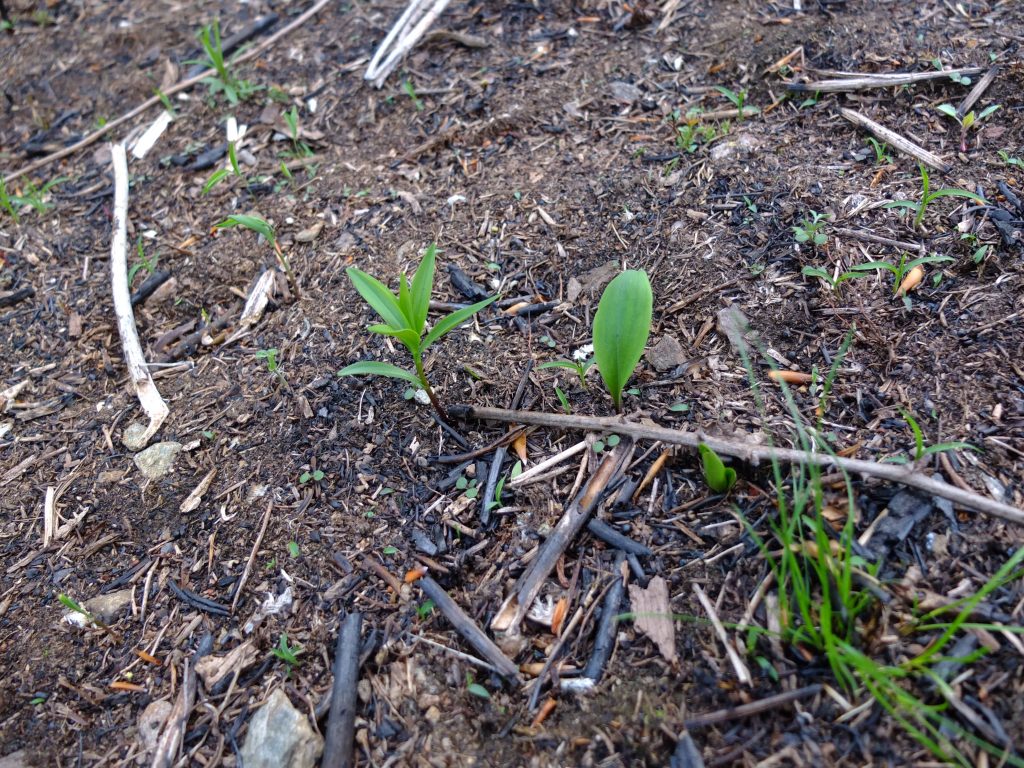
Turk’s cap lily: mature flowering plant (whorl of leaves on the left), first or second year seedling capturing solar energy (single wide leaf to the right) 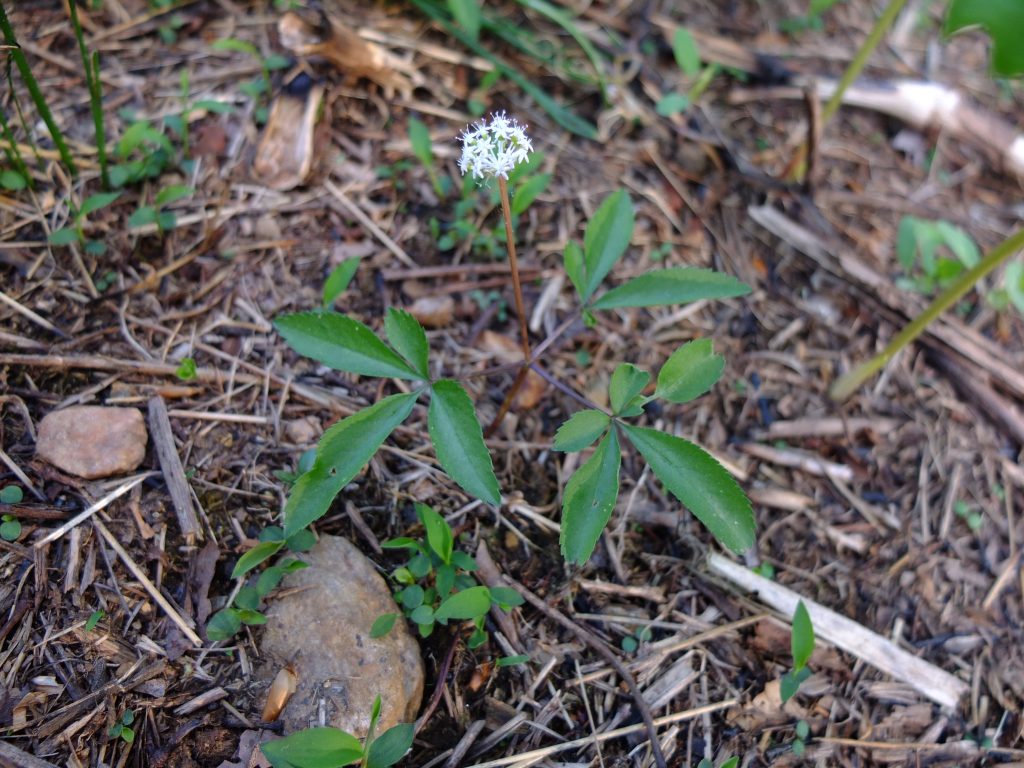
Dwarf ginseng 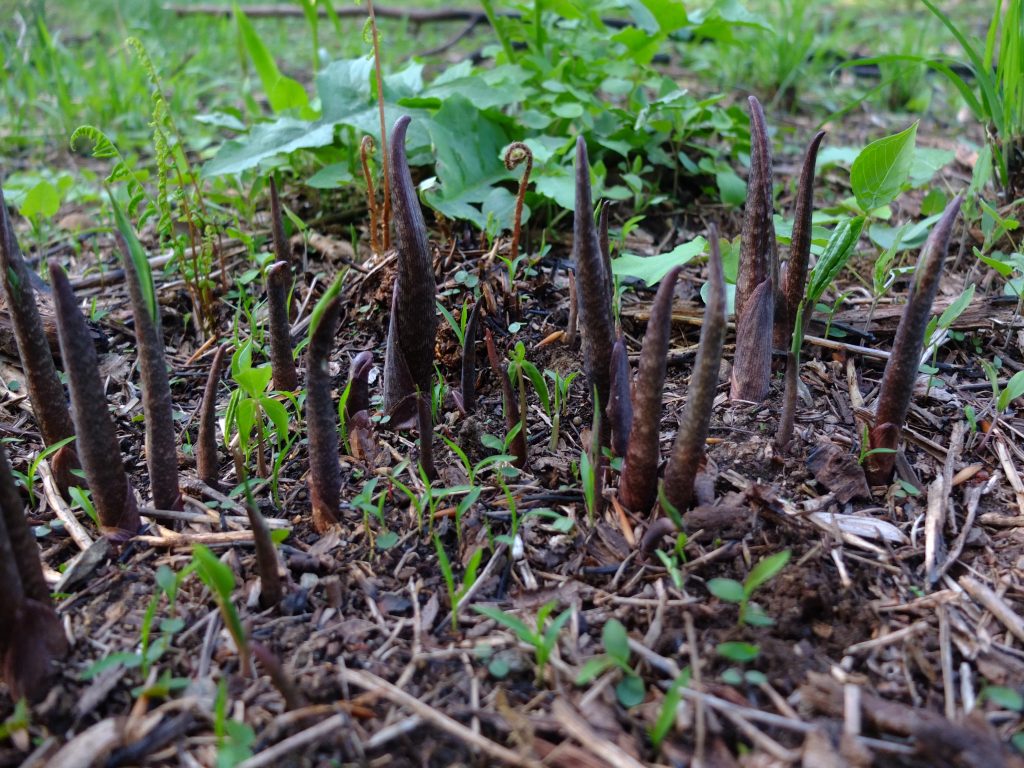
Jack-in-the-Pulpit shoots 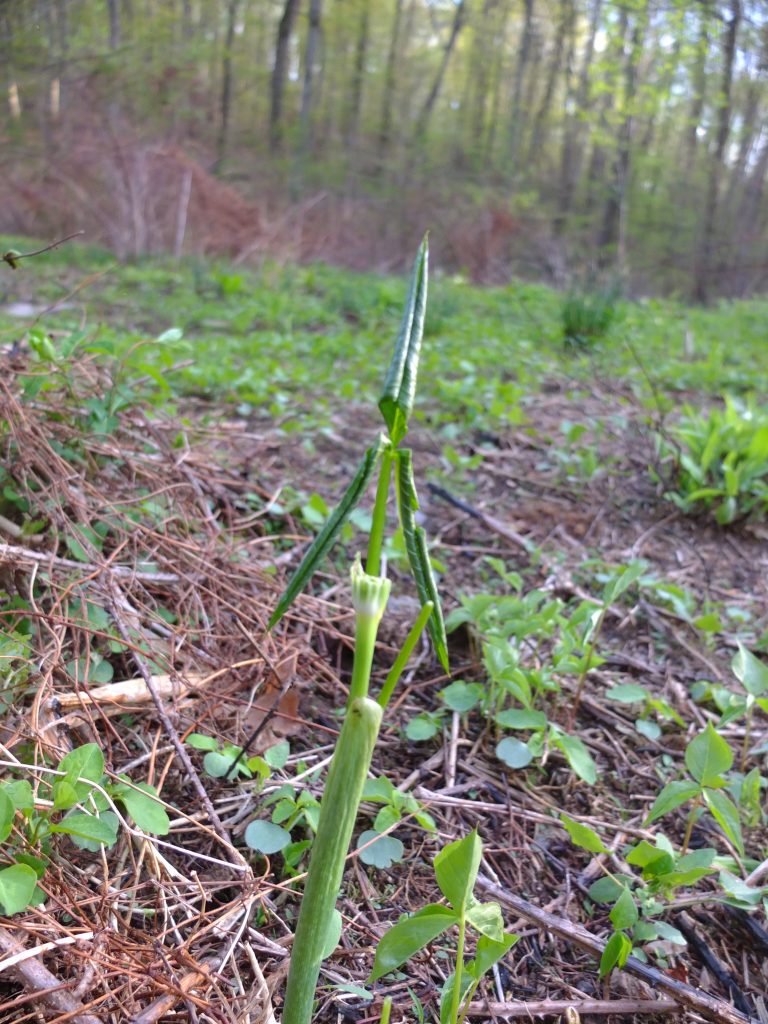
Jack-in-the-Pulpit 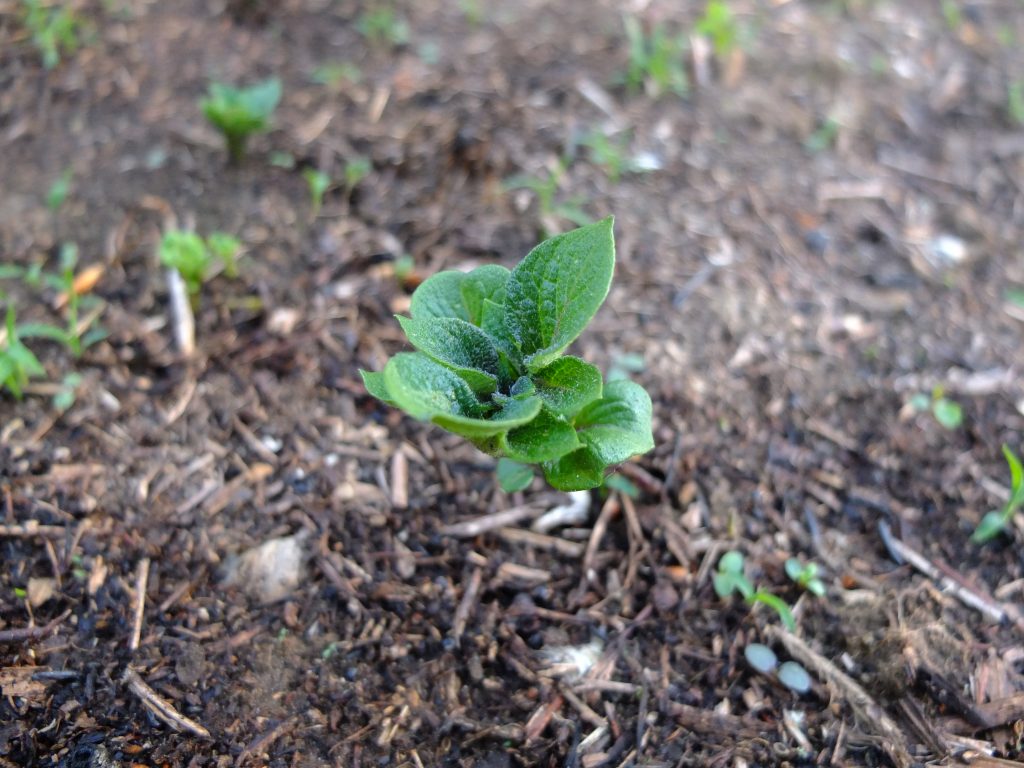
Andean potato 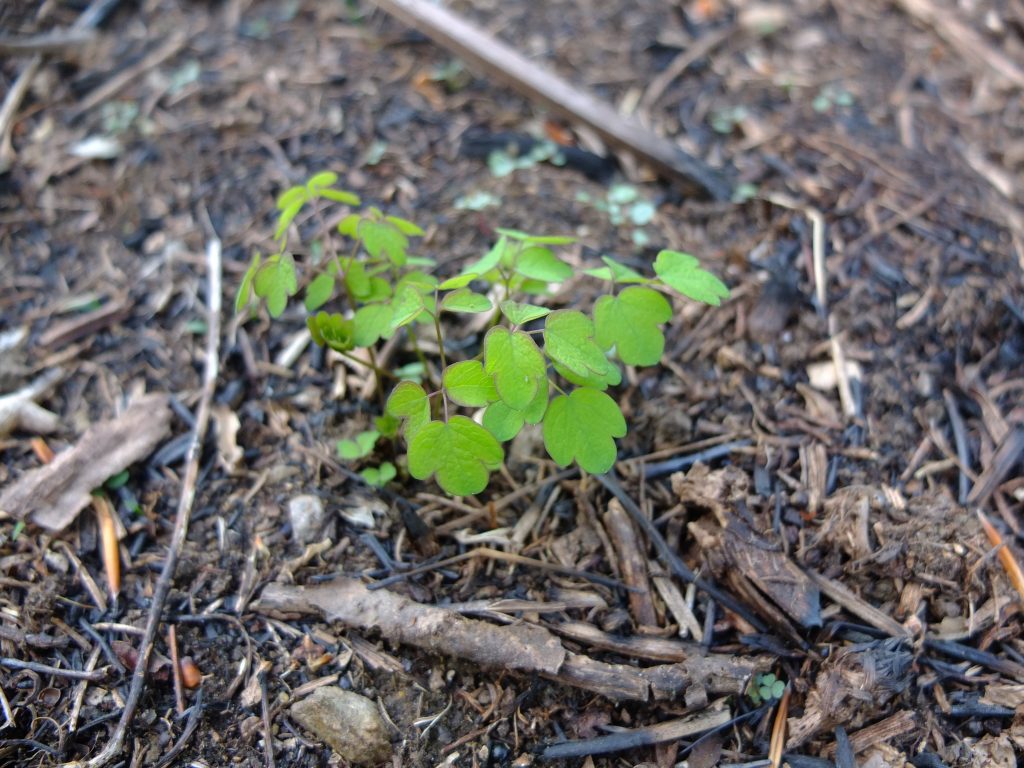
Meadow-rue 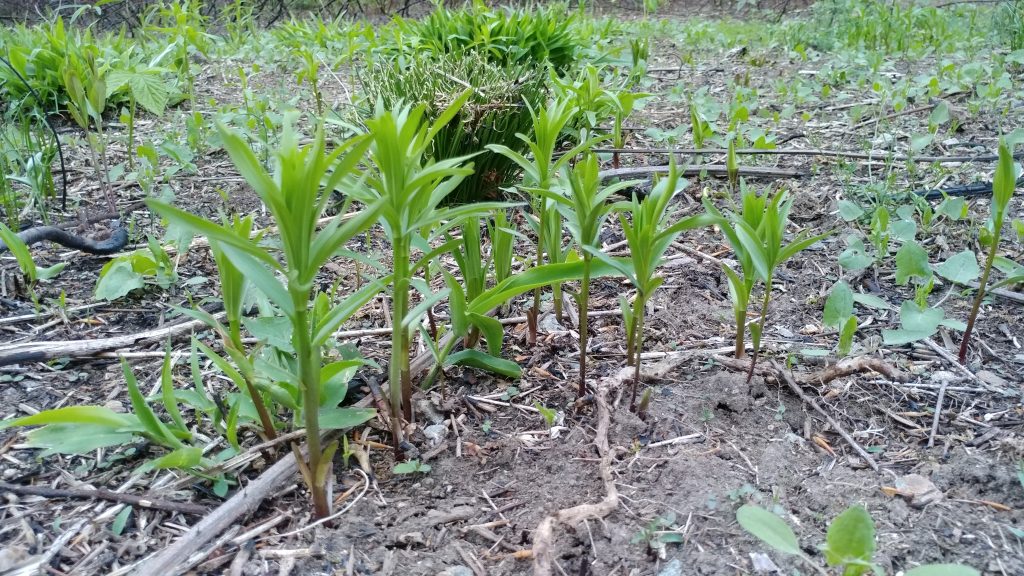
A healthy colony of Turk’s cap lily 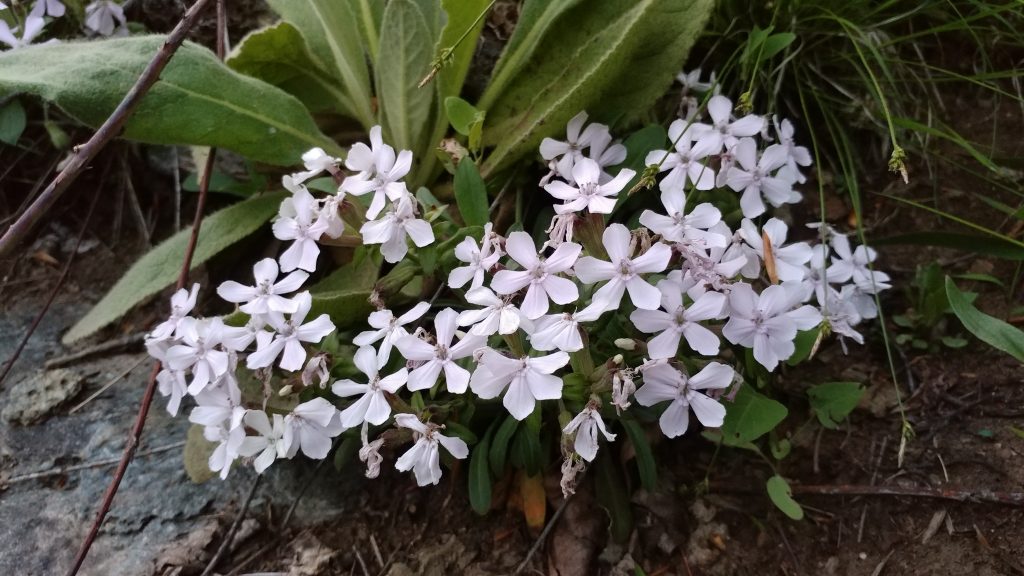
Wild pink 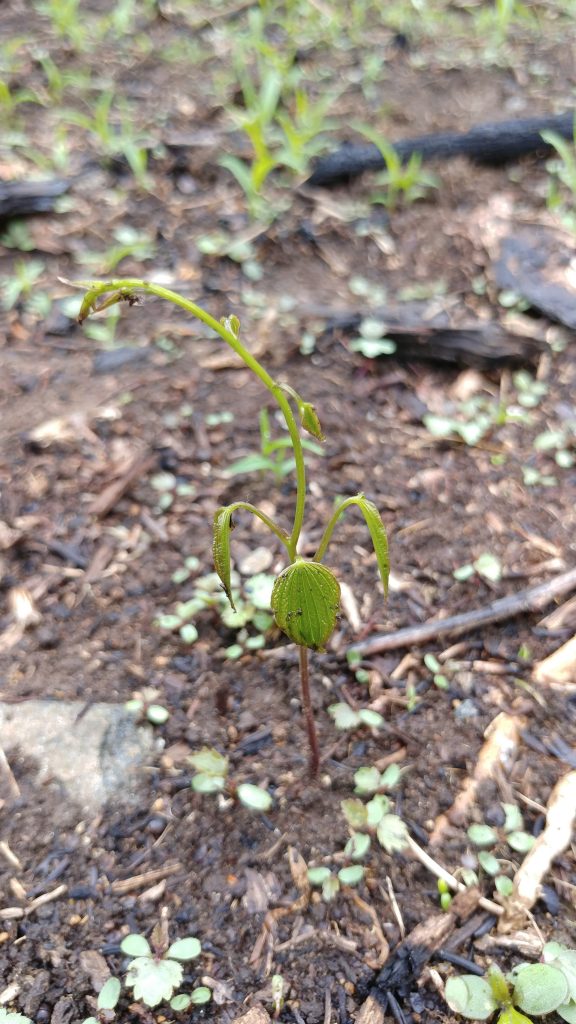
Wild yam 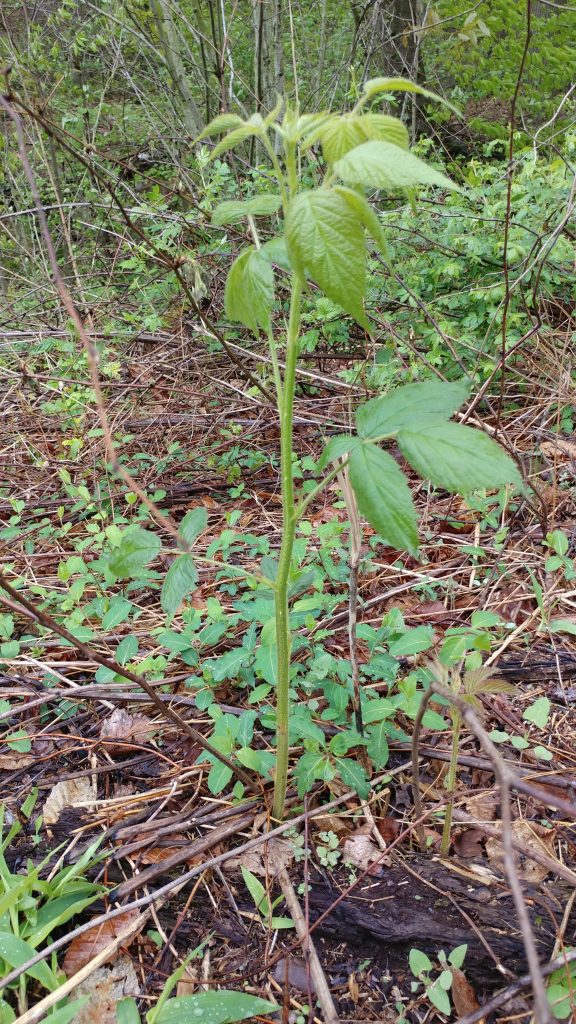
New blackberry cane shooting up 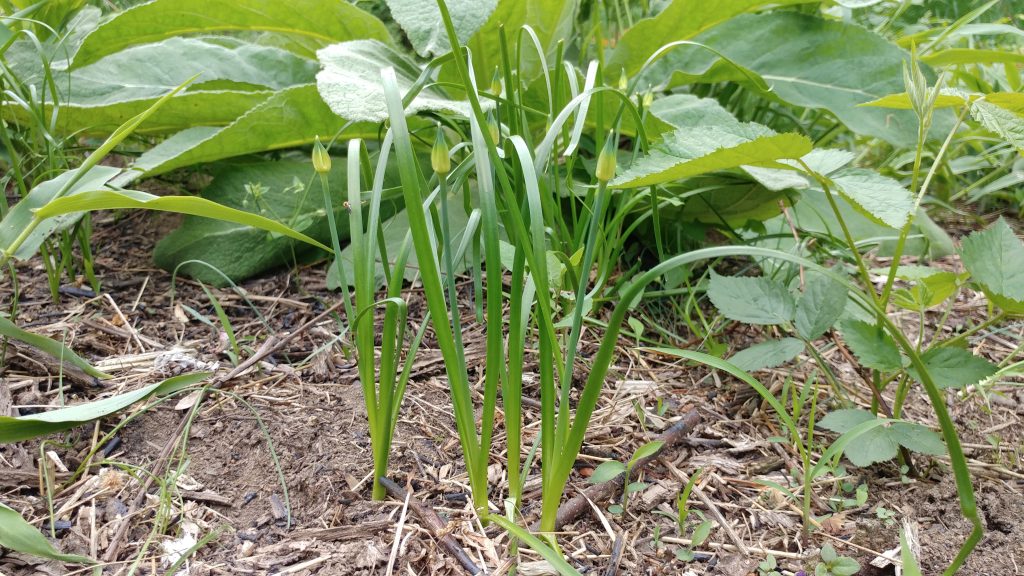
Wild Canada garlic 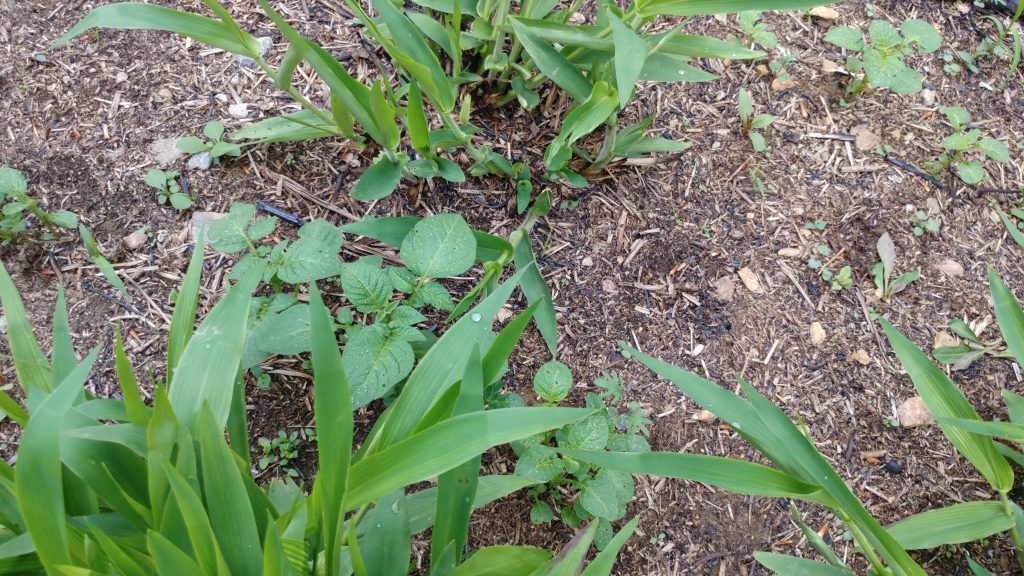
Andean potatoes among the foxtail grasses 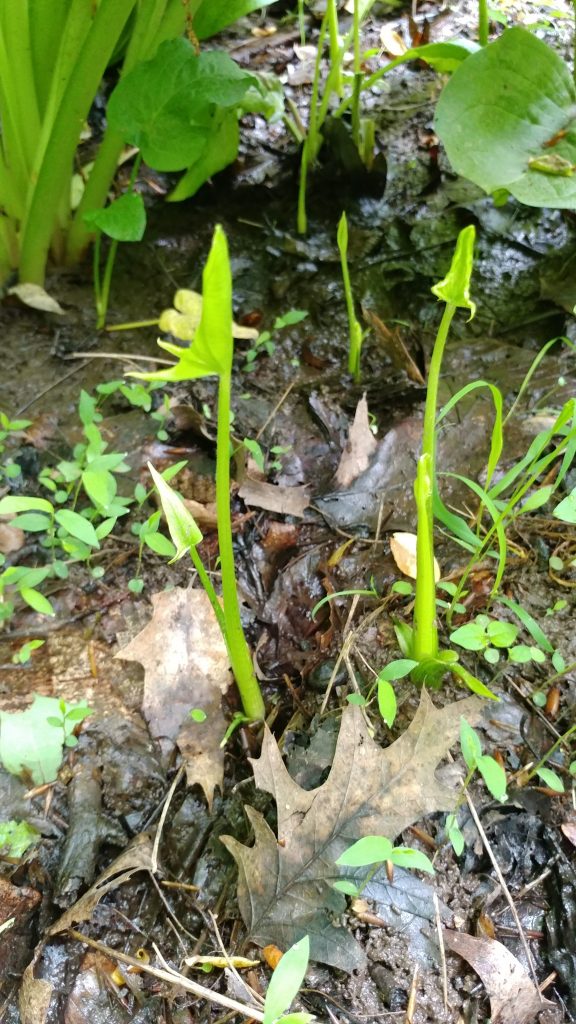
Wapato shoots 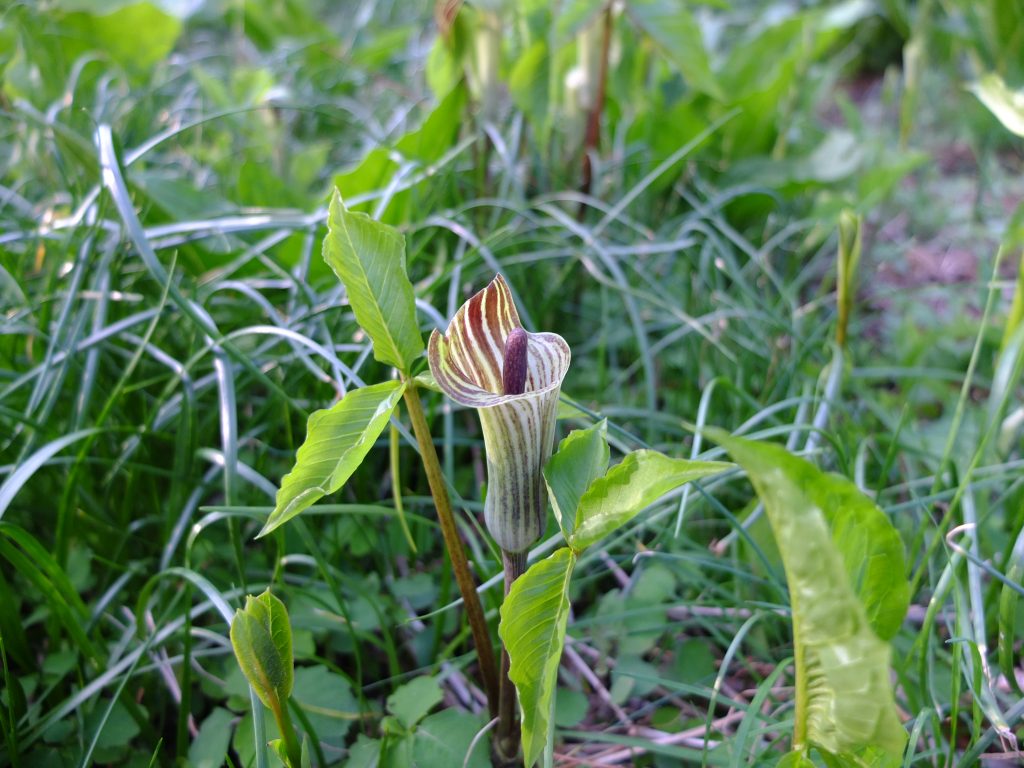
Jack-in-the-Pulpit flower 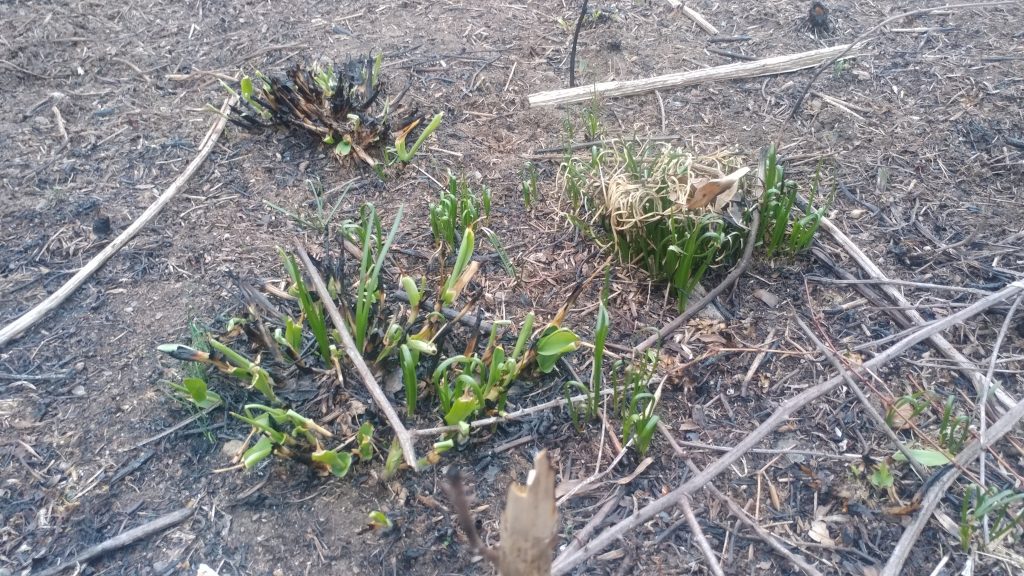
The resprouting culms of deer-tongue grass post-burn
By summer 2019 several more wildflowers reveal themselves: meadow beauty (Rhexia virginica), tobacco-root (Lobelia inflata), St. John’s Wort (Hypericum perforatum), joe-pye (Eutrochium purpureum), tall boneset (Eupatorium perfoliatum), Venus’ looking-glass (Triodanis perfoliata), blue-eyed grass (Sisyrinchium angustifolium), marsh skullcap (Scutellaria galericulata), whorled loosestrife (Lysimachia quadrifolia), and fringed sedge (Carex crinita). This all is in about a quarter-acre burned floodplain area. Lots of diversity and richness for such a small area.
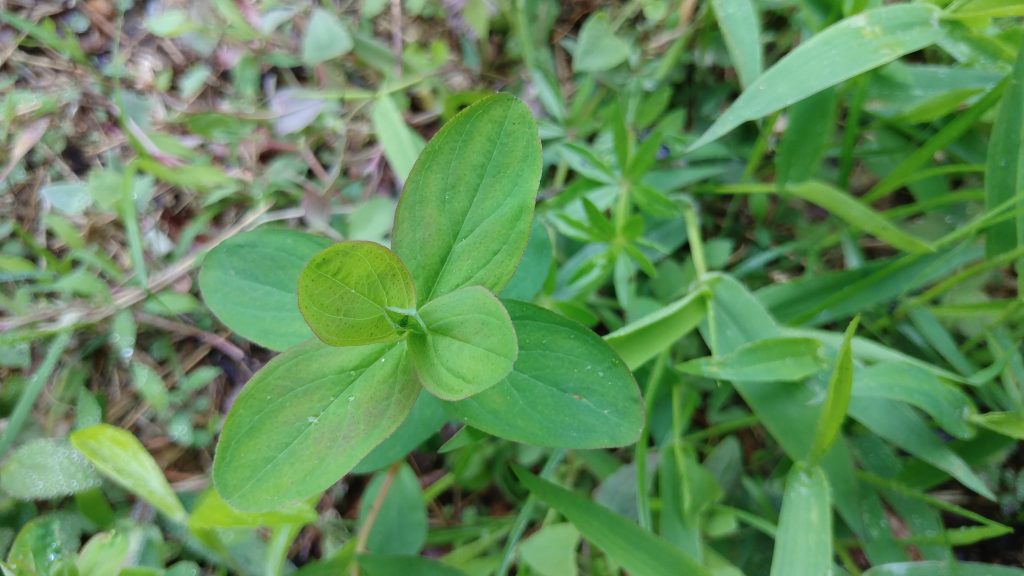
Hypericum perforatum 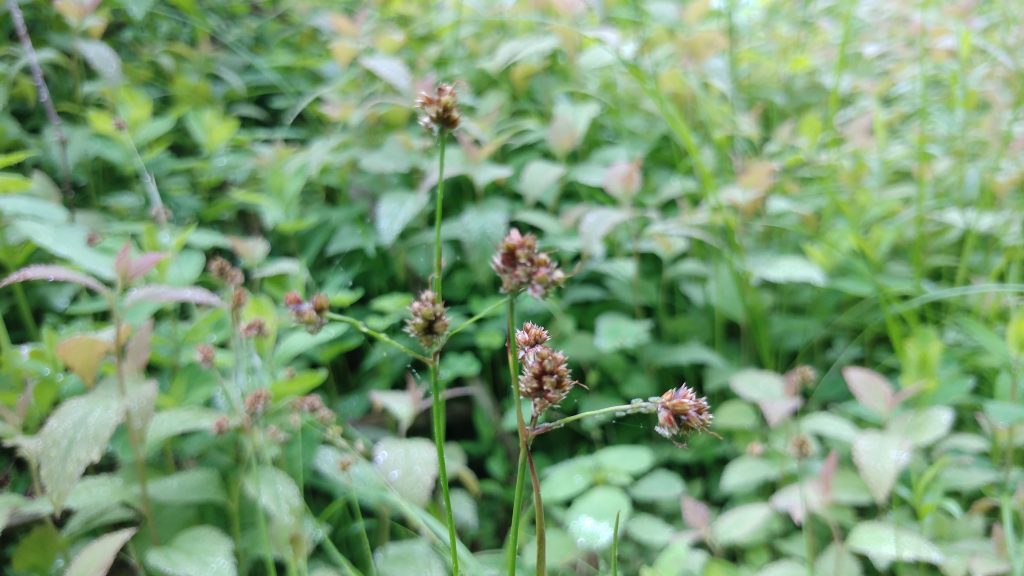
Unidentified sedge or rush 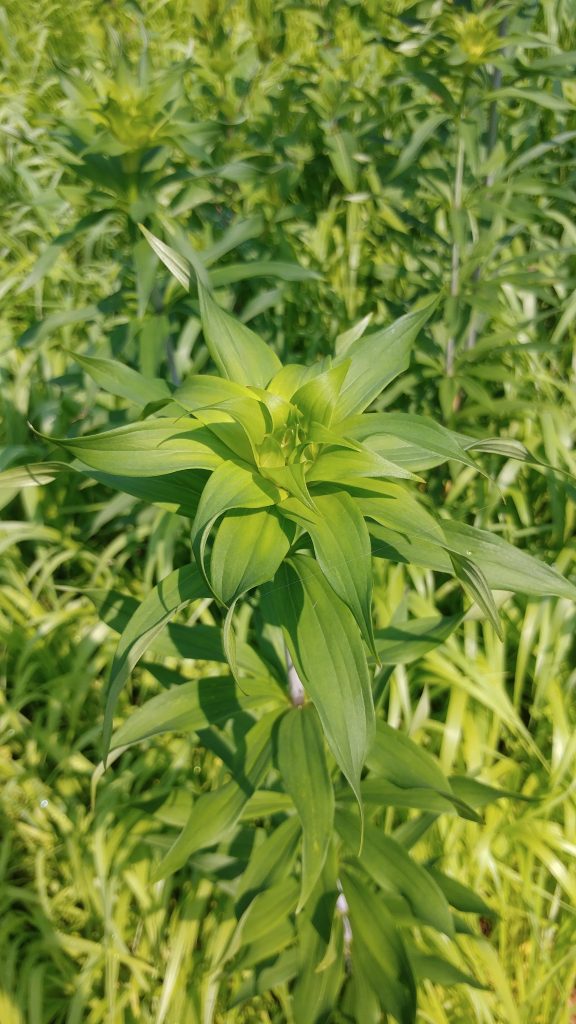
Turk’s cap lily before flower 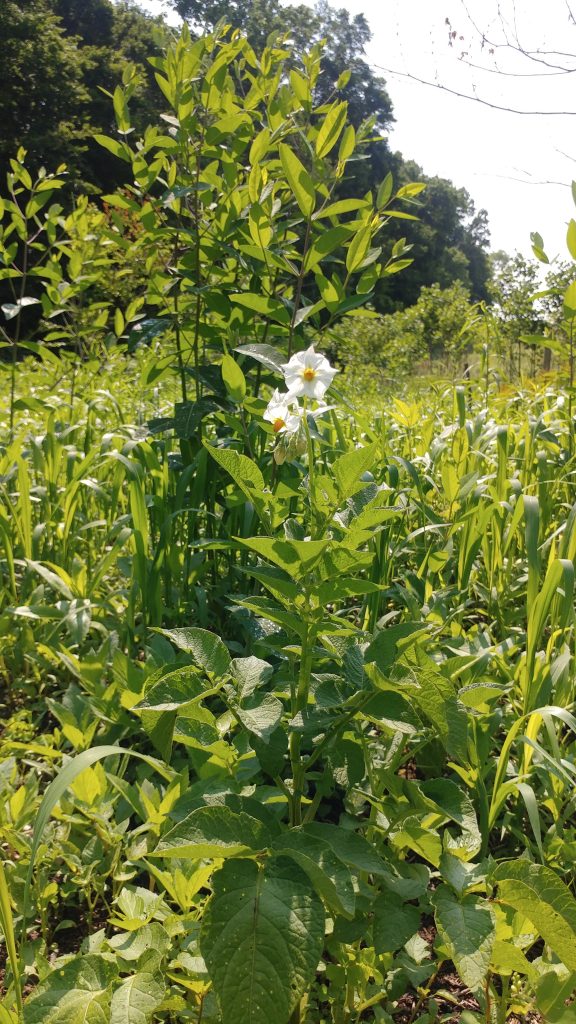
Andean potato, flowering 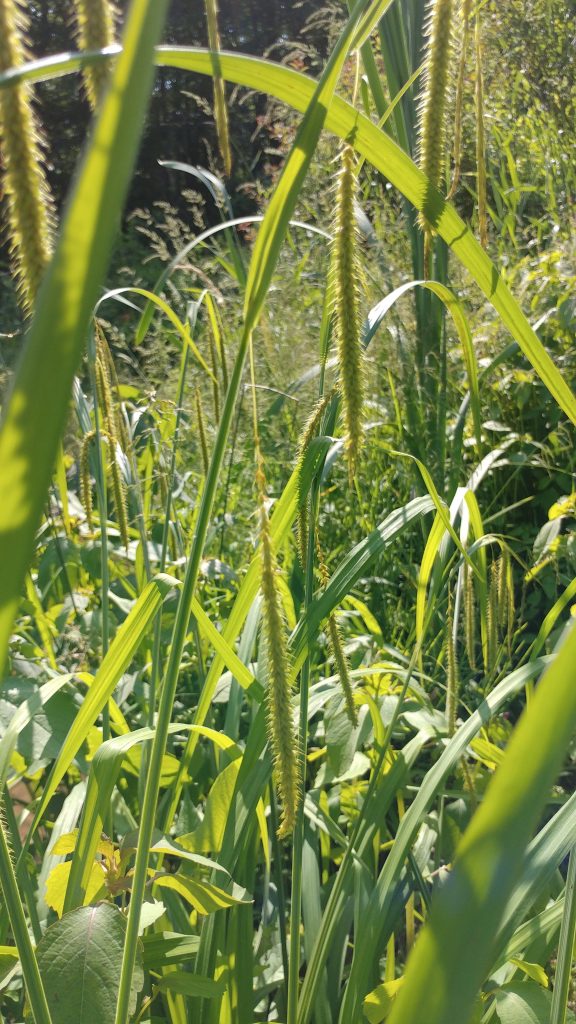
Fringed sedge, Carex crinita 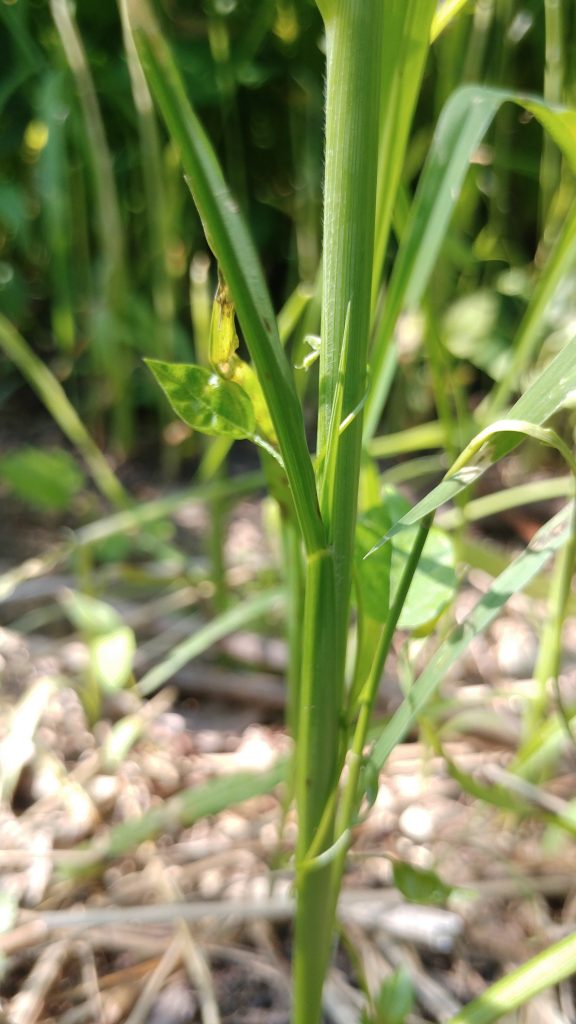
Apios americana seedling climbing up fox-tail grass 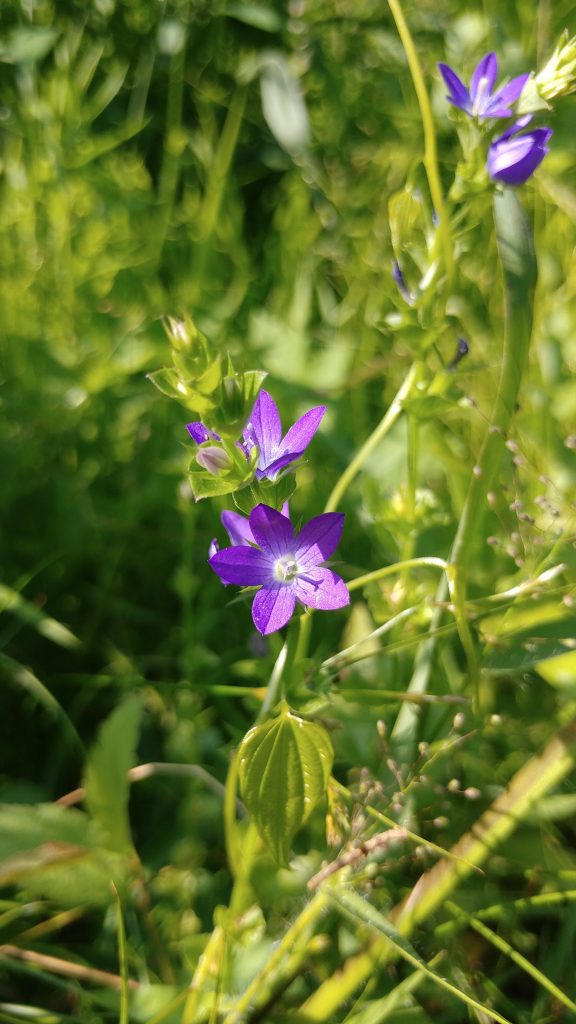
Venus’ looking glass 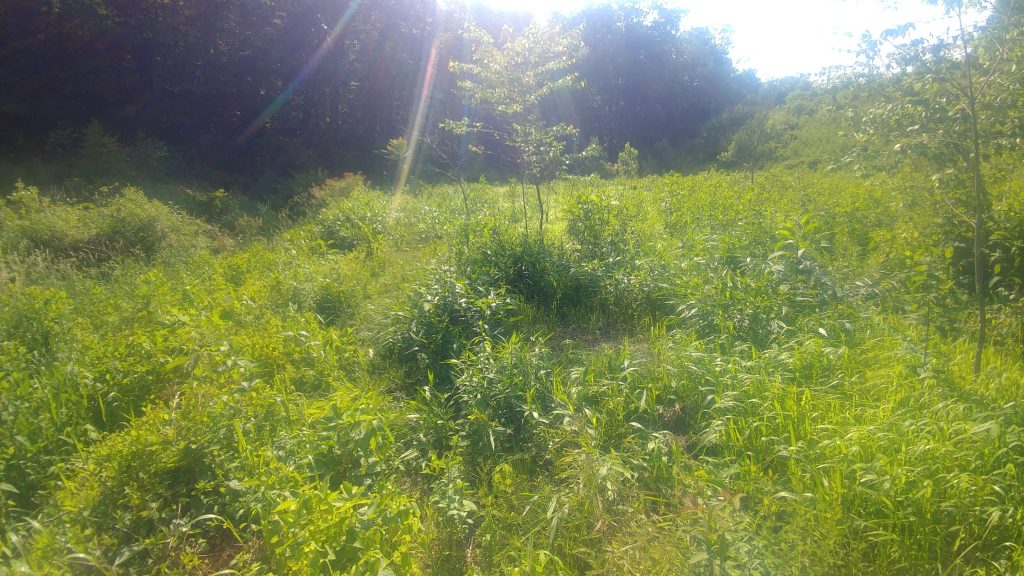
The raucously growing early summer meadow, post-burn 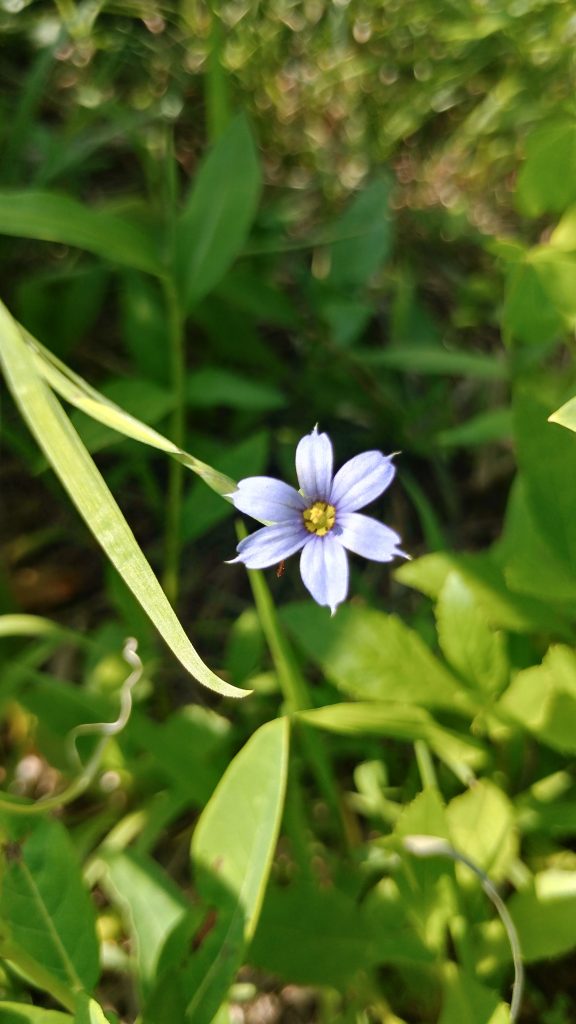
blue-eyed grass 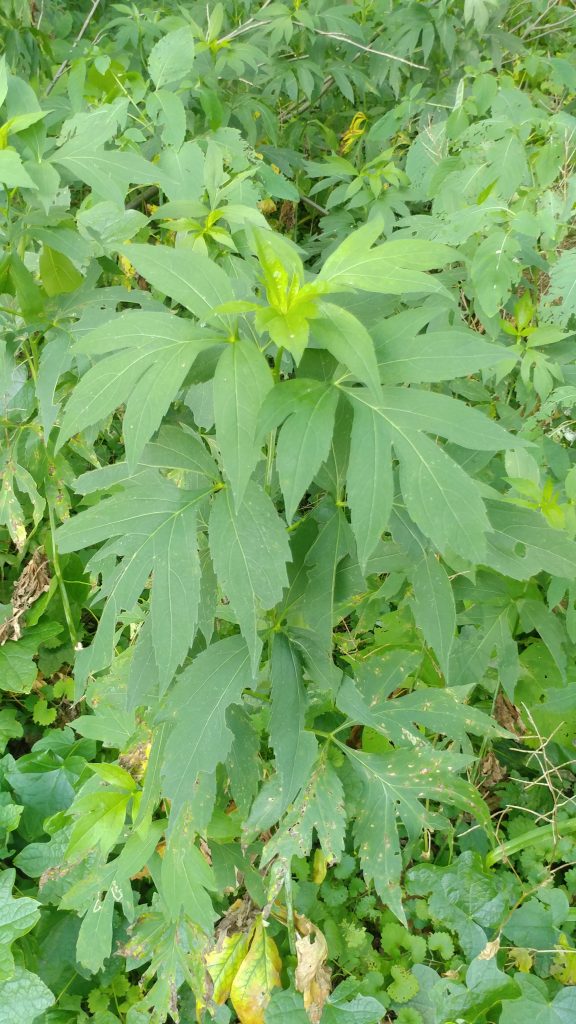
Sochan before flowering 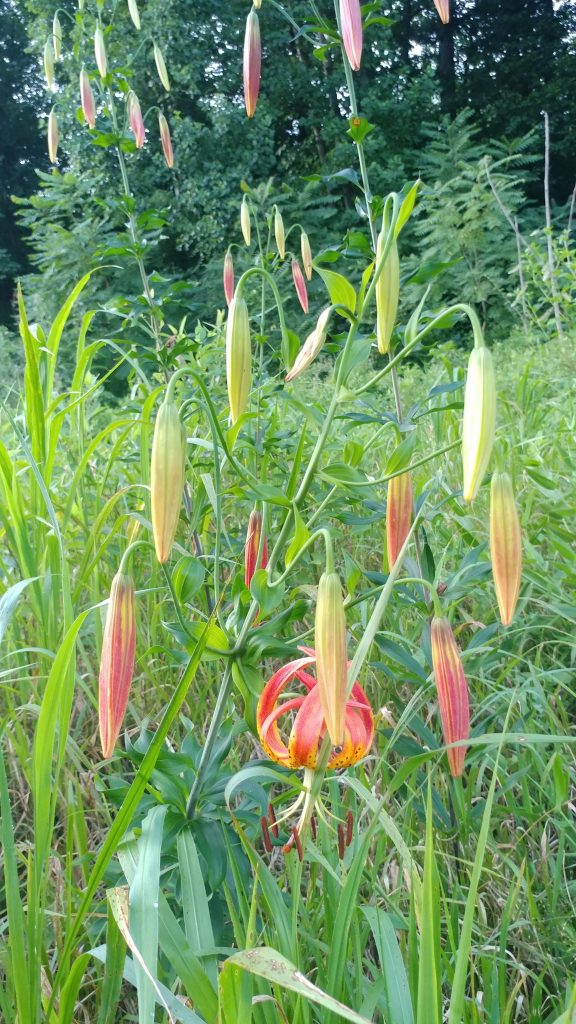
Turk’s cap lily beginning to flower 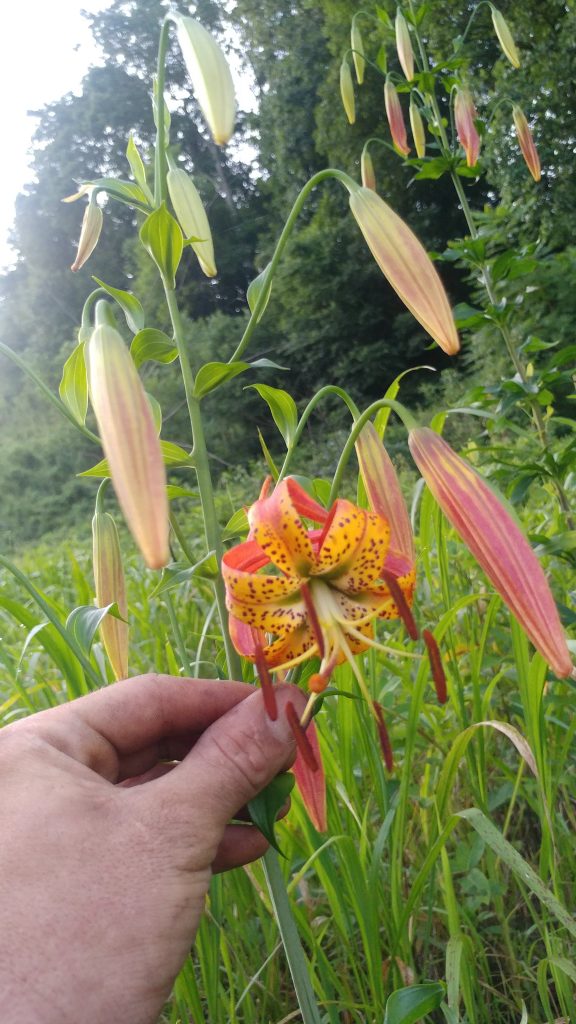
Turk’s cap lily 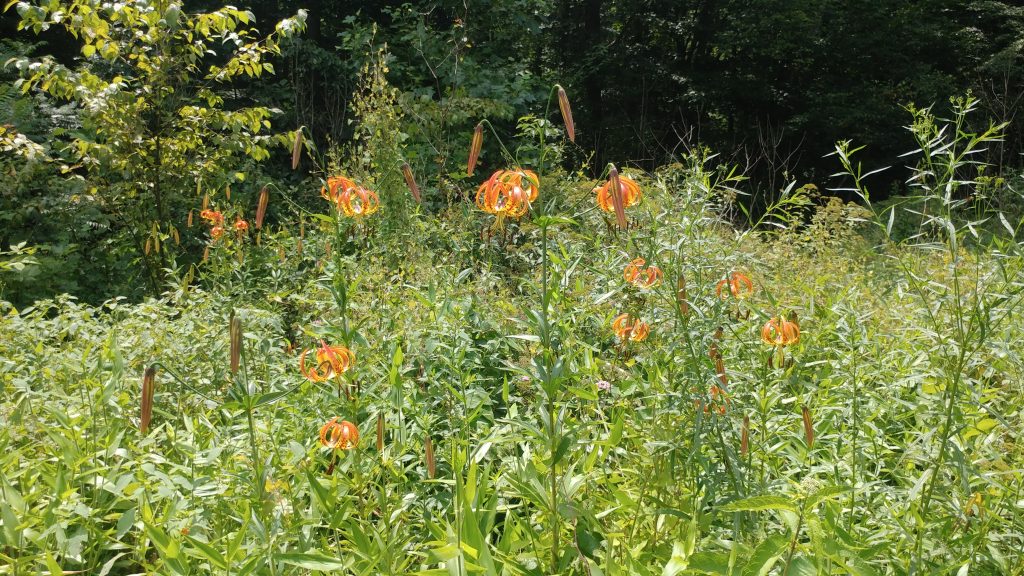
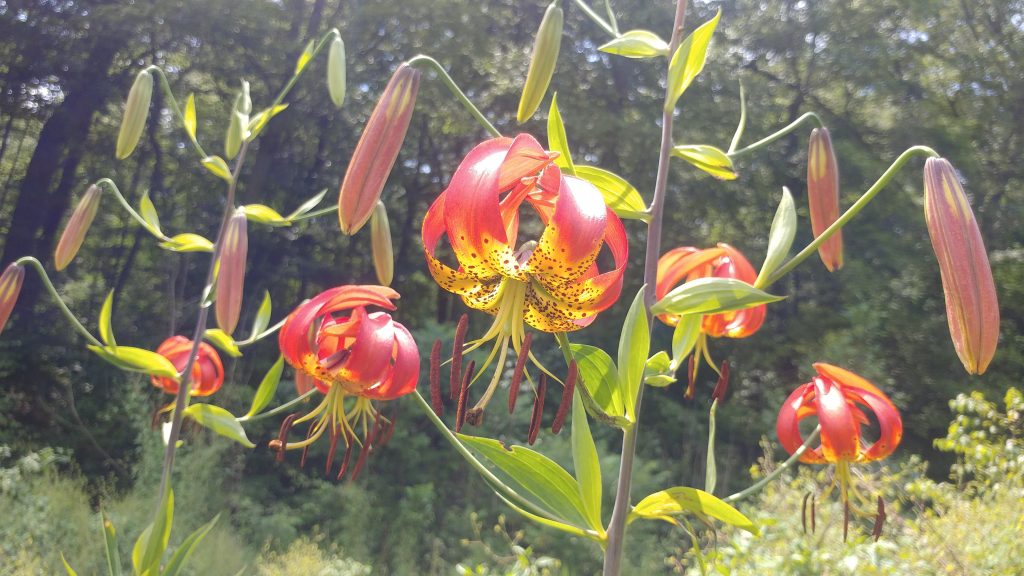
Wow! 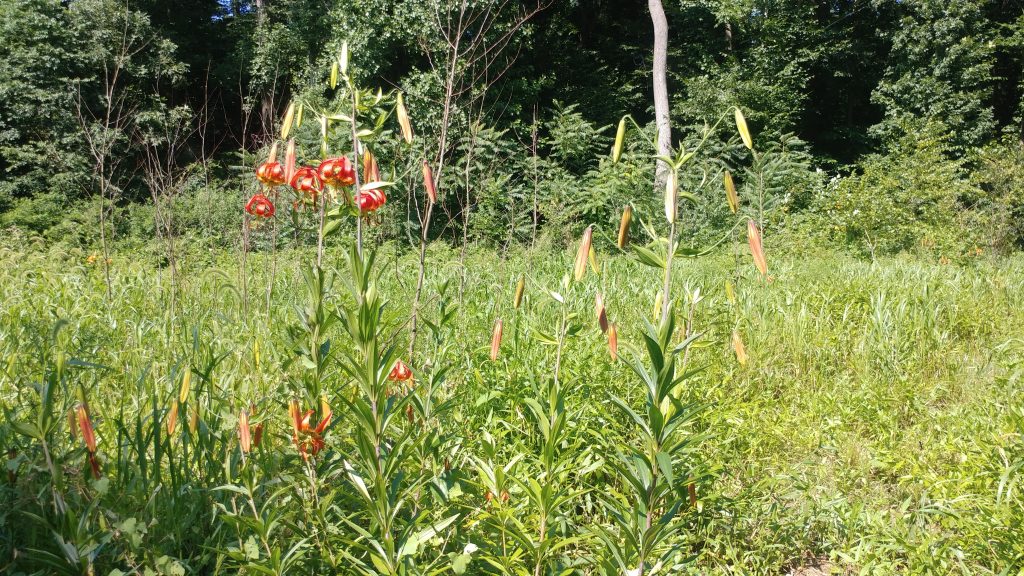
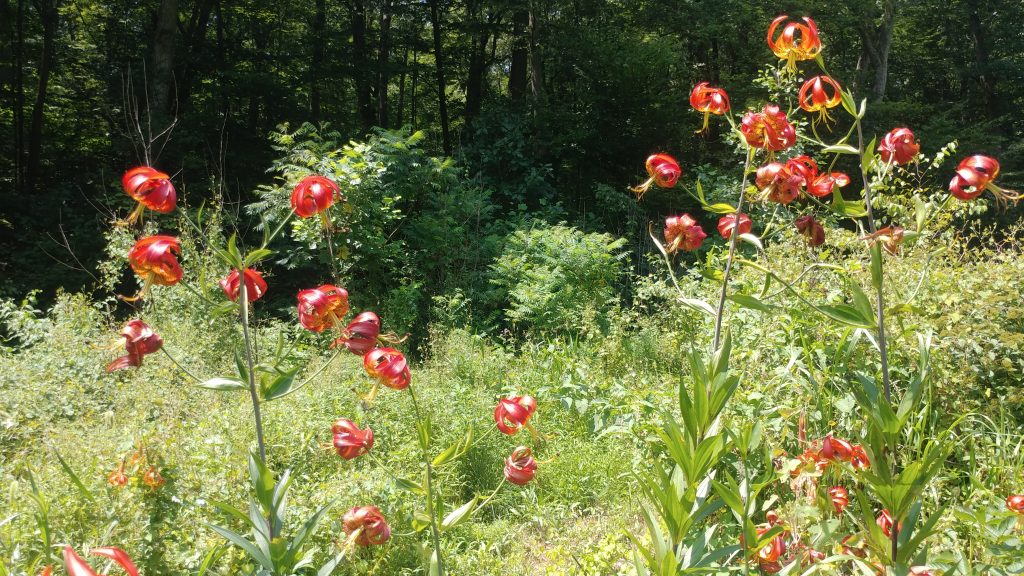
What a show! 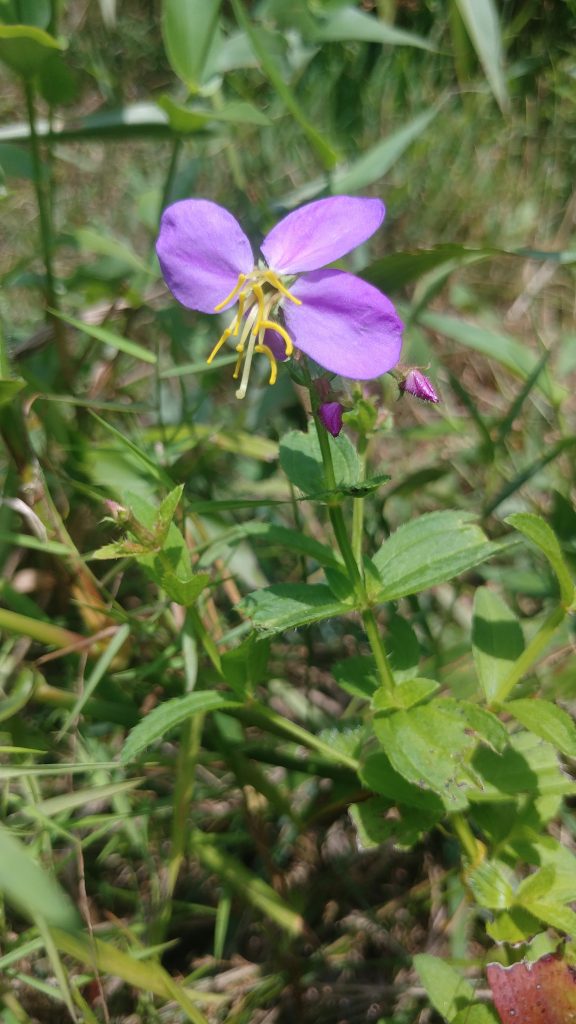
Virginia meadow beauty 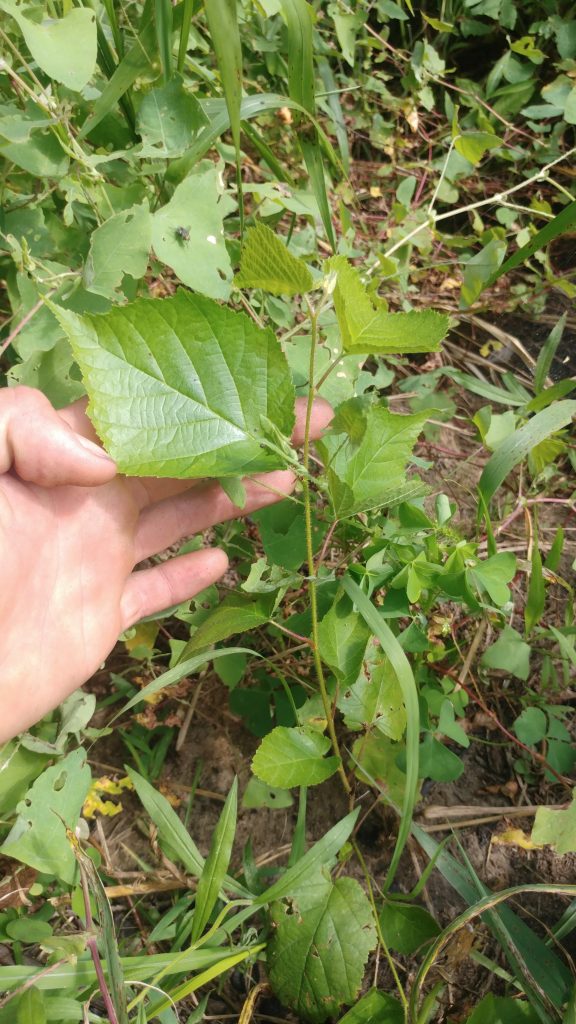
Hazelnut seedling grown up from seed plunked in the ground 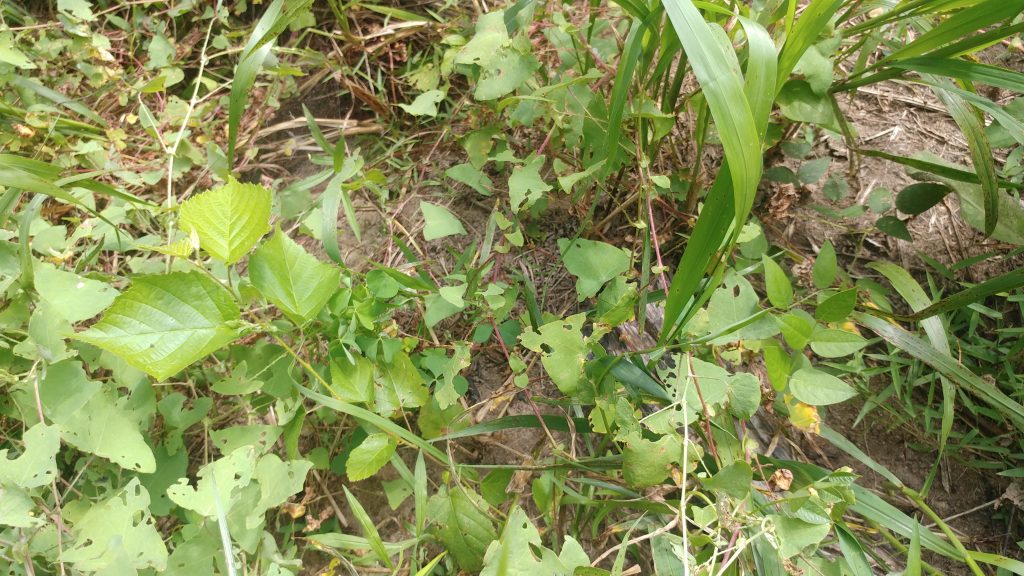
American hazelnut from seed with introduced groundnut vine beside 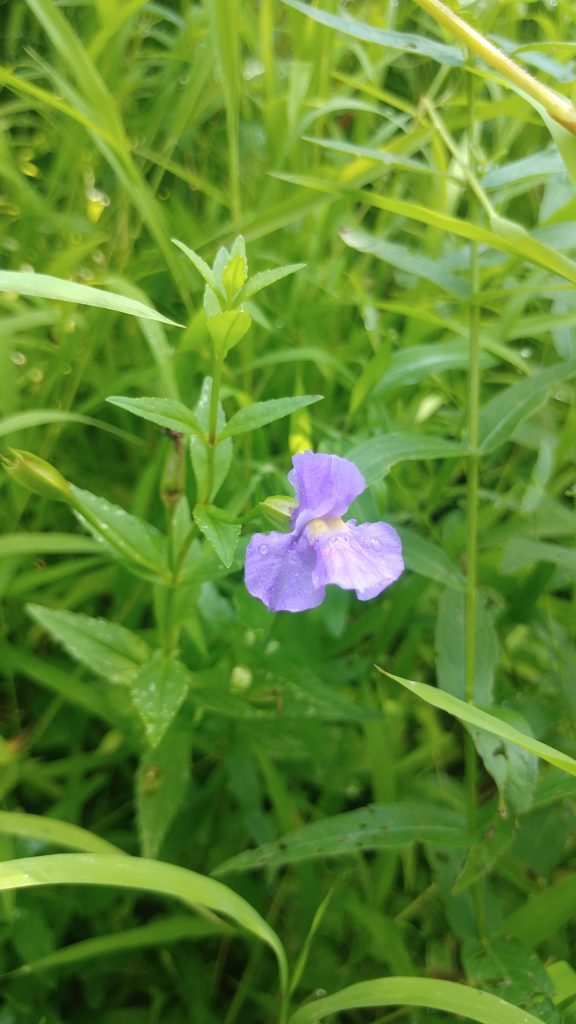
Marsh skullcap 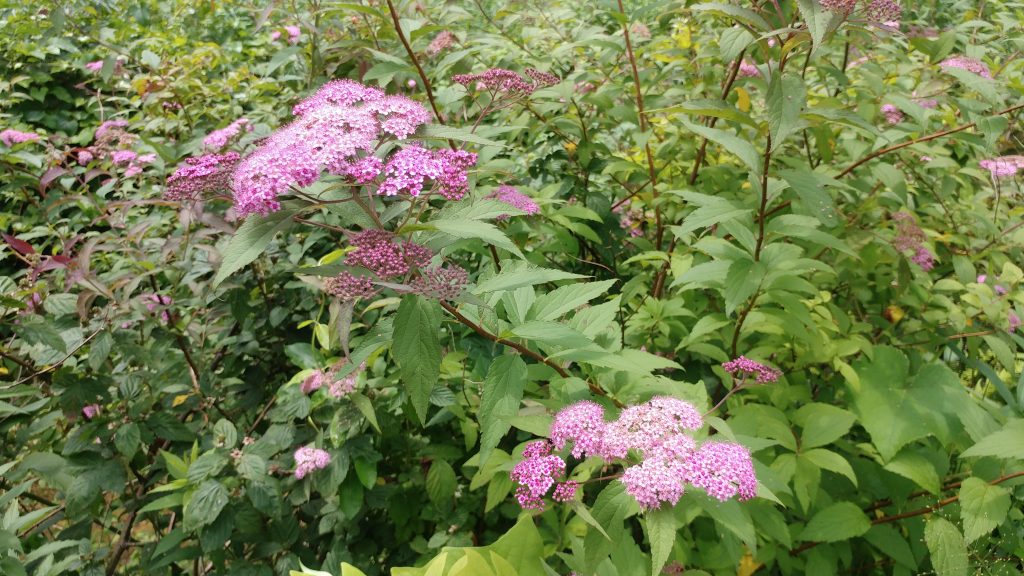
Japanese spiraea 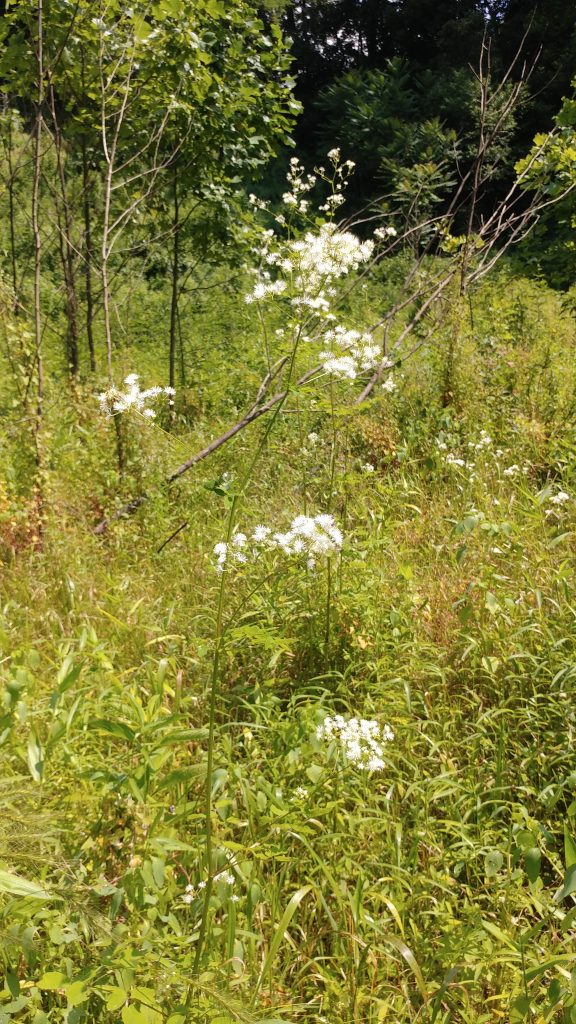
Meadow-rue 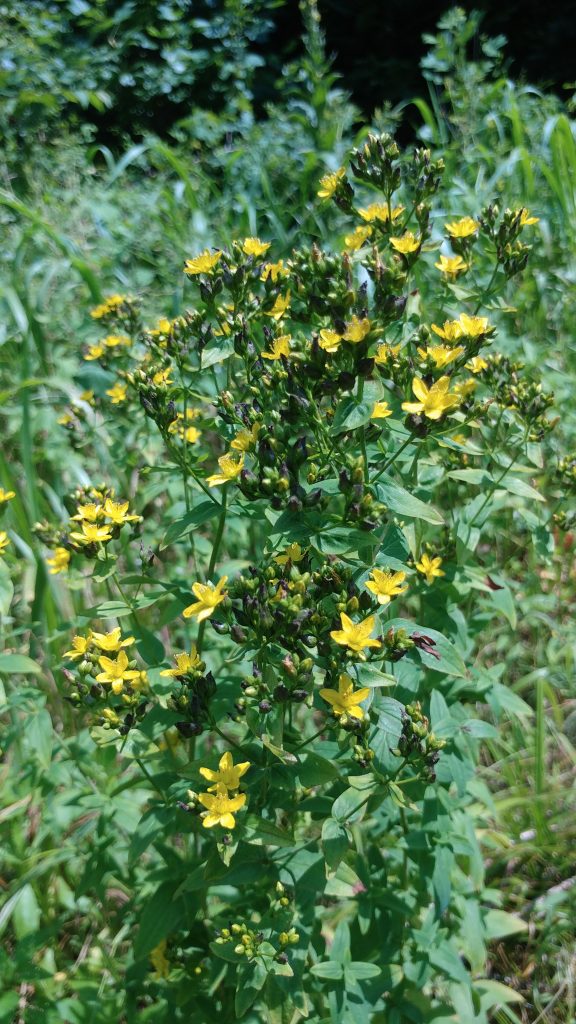
St. John’s wort (Hypericum perfoliatum) 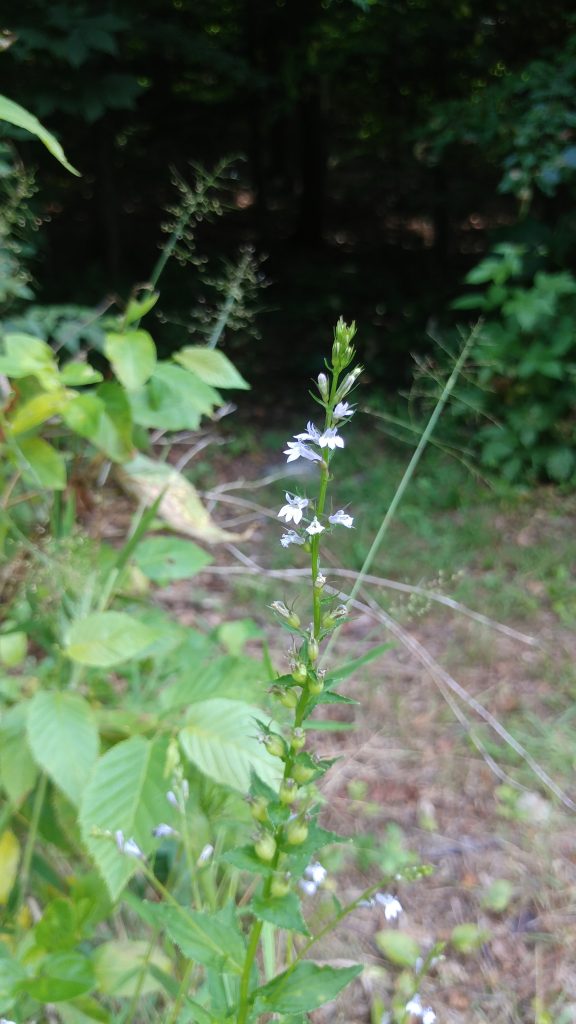
Tobacco root (Lobelia inflata) 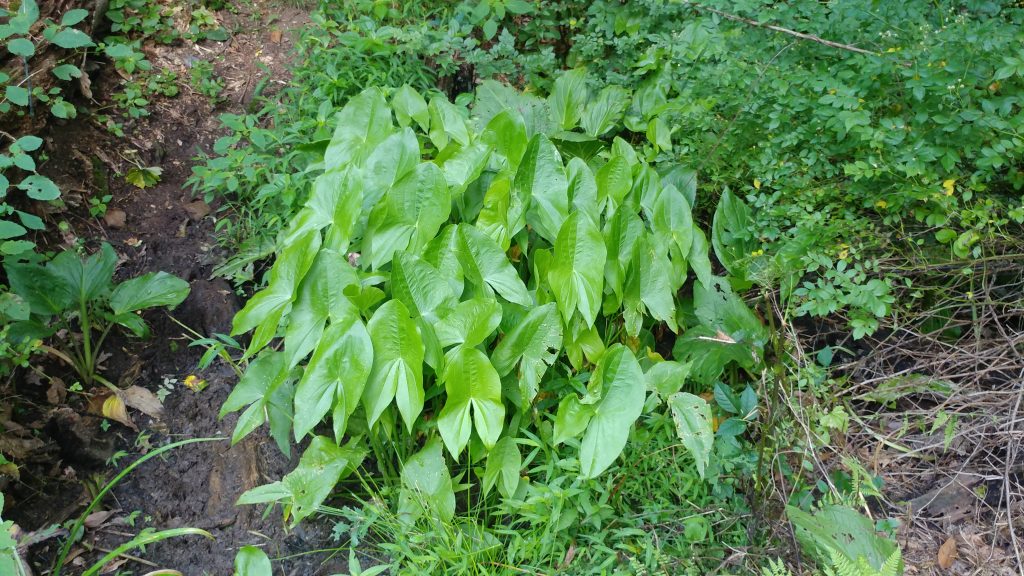
Happy wapato colony 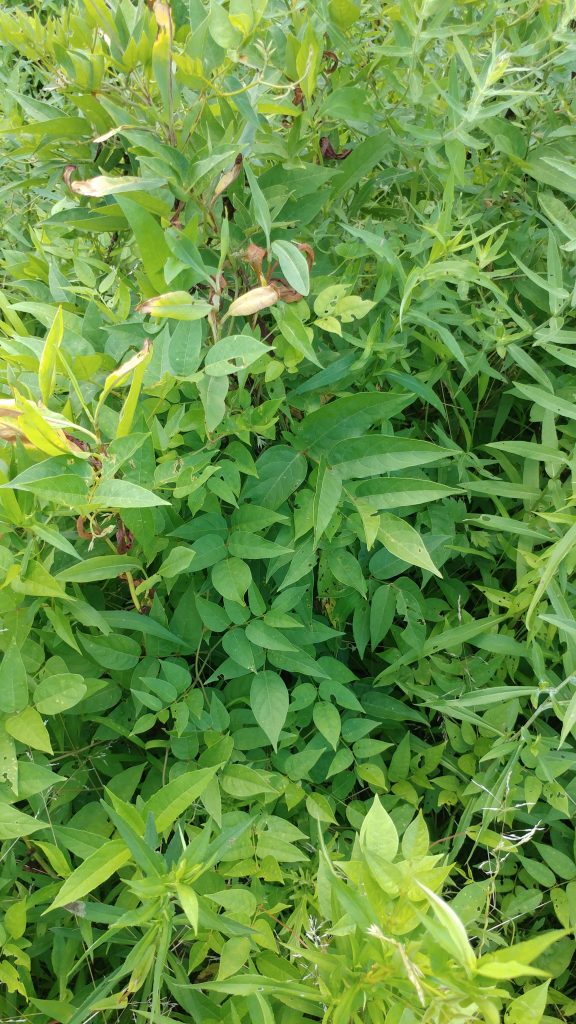
Happily sprawling groundnut vines
And towards autumn, by about the middle of August: goldenrods (Solidago spp.) began showing up, as well as the lovely fall witchgrass (Digitaria cognata).
Things I added in year one (2019) included: American hazelnuts from seed (Corylus americana), groundnuts from seeds as well as tubers (Apios americana), some hickory nuts (shellbarks and hybrids), transplants of wild strawberry (Fragaria virginiana), transplants of spring beauty (Claytonia virginica), and seeds of wild bean (Phaseolus polystachios) and earth bean (Amphicarpaea bracteata). I also transplanted a root cutting of running serviceberry (Amelanchier spicata/stolonifera) from out of the deeper surrounding woods where it couldn’t get enough light for fruiting, and into the open burned area where it could. Just for the heck of it, I also added some extra Andean potatoes I had lying around, which to my surprise did well even into the late summer among the tall grasses, and which gave me a yield of delicious root vegetables.
I added American plum seeds (Prunus americana) to some nearby areas, though not here in the actual burn garden. I also grew vegetables in a plot nearby using similar methods. These were maize, taro, yacon, sunflower, potatoes, sweet potatoes, turmeric, skirret, and parsnips — my go-to staples. Including a few of these crops is an example of how the boundaries between fire-stick farming and forest-fallow shifting cultivation (or swiddening) are fuzzy — part of a continuum.
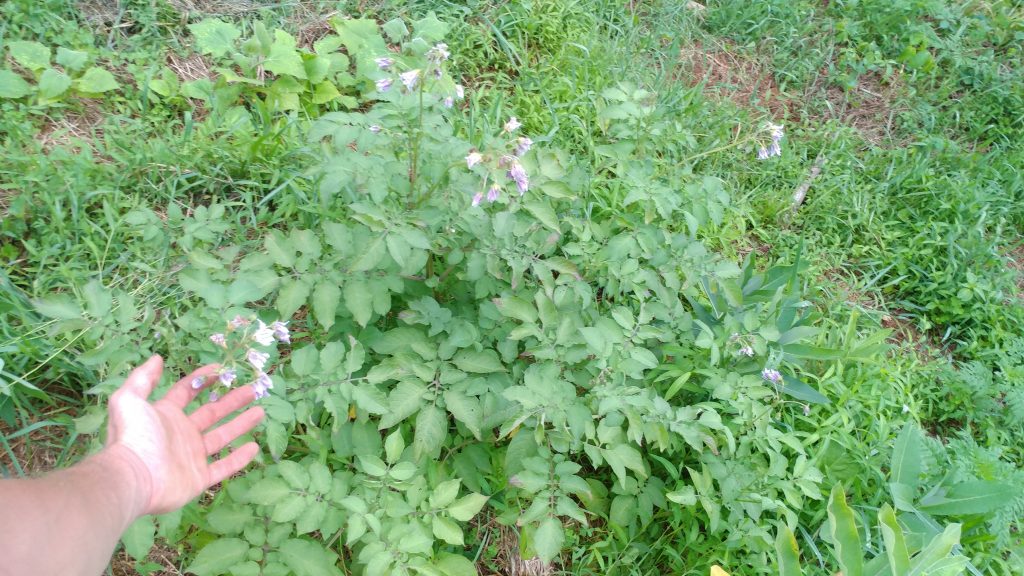
Andean potato bushes 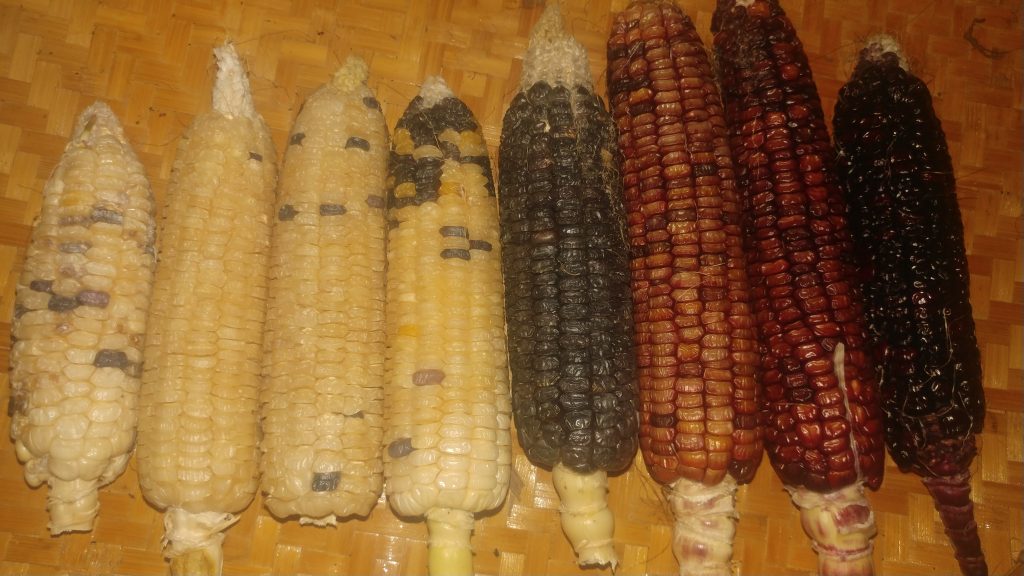
Landrace maize
As the Apios groundnuts establish themselves another year throughout 2020, next year in 2021 they should be at the point where they will produce seeds, and I can start digging them every season. For now my annual harvest includes mostly wild root vegetables like the wapato, jack-in-the-pulpit corms, lily corms, and little spring roots like the dwarf ginseng (extremely abundant in surrounding forest), and the planted Andean potatoes in the clearing. In the surrounding forest, as well as in the burn garden itself, there are countless edible greens, medicines, fruits (persimmon, pawpaw), berries (serviceberry, wild gooseberry, wineberry, black raspberry, blackberry, autumn olive), and nuts (acorns, hickories, and walnuts).
Landscapes like these are true food forests, and almost all of it is natively here already without my intervention, and the cultivation I do is limited, easy, efficient, and intended to guide the long term ecological succession of the space. Fire is a powerful ally and burning represents only the first step in the seasonal cycle. Due to fire’s efficiency I don’t have to do the work of tilling or weeding, which makes the work of “cultivation” feel like cheating.
Also note: when I say many of these species are “here natively” already, I’m leaving out the vast, long, and storied ethnobiological history and legacy of the indigenous peoples of Turtle Island. On closer examination of the co-evolution of plants and people, simple dichotomies of native vs. naturalized vs. exotic disintegrate. Itis important for me to acknowledge that in this work I am standing on the shoulders of giants.
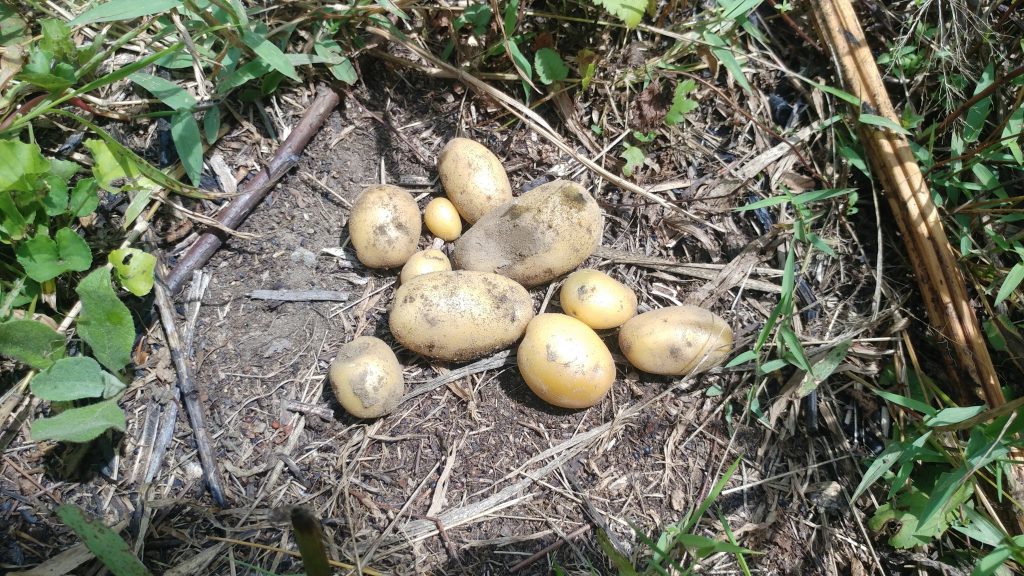
Andean potato harvest. This is from just a single plant. Pretty happy with this yield, especially because the only work that went into it was putting the seed potatoes into the ground, and then digging them up when they were ready. 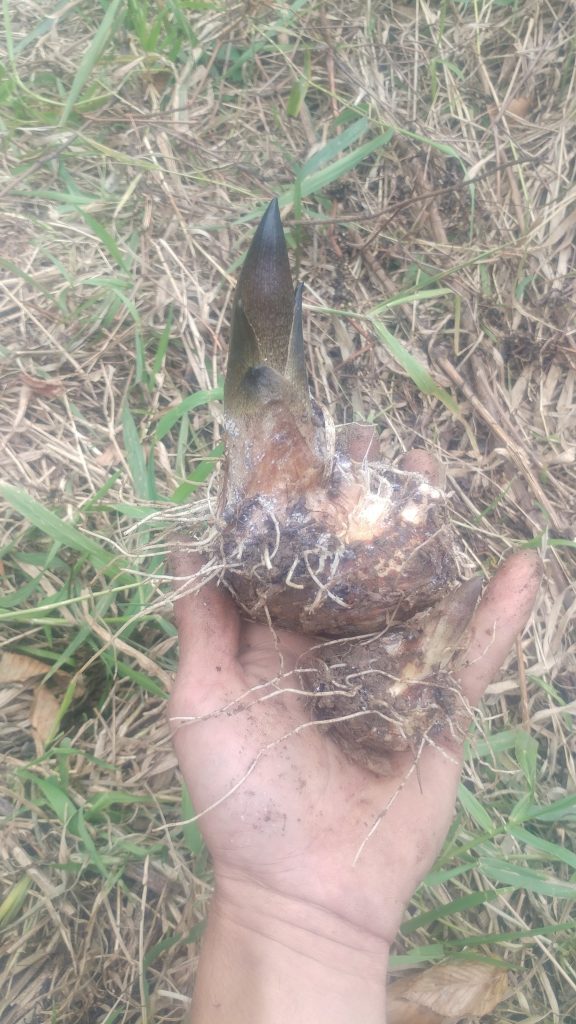
Jack-in-the-Pulpit corms can grow to massive sizes, are very abundant, but require a lot of drying and cooking before they are edible. 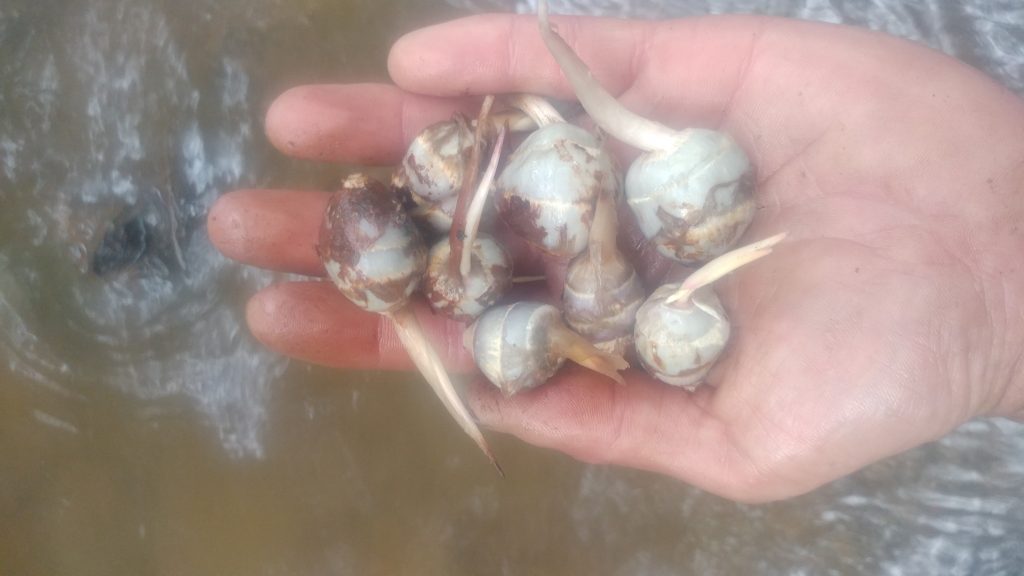
Delicious tubers of wapato.
Year 2, the second firing (winter 2019 – early spring 2020):
Here in the second spring of observation in this burn garden, I see that the hazelnuts are still going strong. With this second firing I accidentally top-killed one of the 1-year-old hazelnuts and the transplanted serviceberry, but both resprouted from their roots and are currently growing very vigorously. The rest of the hazelnut seedlings were unscathed because I raked around them prior to burning.
Wild strawberries which were transplanted last year have exploded post-burn, extending their foot-long and longer tendrils in every direction, sending down new root nodes and colonizing all the bare soil they can find before the grasses grow back. The naming of “strawberry” makes so much sense to me – the berries that grow in the “straw” or thatch of dried, dessicated grasses, especially perennial grasses in grassland/savanna landscapes which have a relationship with fire. Char and Ash from the fire raises the pH thus increasing the bioavailability of calcium, which makes the strawberries grow stronger, better, faster, bigger, and sweeter. The approximately four transplanted wild strawberries I planted last year in 2019 have become about a dozen or more clusters, many of which have flowered and are developing their fruits.
I’ve also noticed that new Apios groundnut seedlings are emerging from the seed that didn’t germinate last year (thus Apios americana seems to sometimes go into a double dormancy cycle, interestingly). To be clear, I mean that of the Apios seed i sowed last year, about half germinated and grew that year, and this year it looks like the other half are now germinating. I am always happy to see more Apios in the world.
The transplanted spring beauty tubers (Claytonia virginica) bloomed well this year, and have made and spread their seeds already.
There seem to be even more mature/flowering Turk’s cap lily than there were last year. We will see come flower time.
A few things I learned about fire:
- If you burn in the late fall, with the onset of winter, cold air is “settling,” which means if burning towards evening, “descending frost” will dampen out your fire as dusk descends. This also means also that the ground will be colder and wetter in the autumn-leading-up-to-winter than it would be if you were burning in the late-winter-leading-up-to-spring. This means your fall burn will be “rougher,” or “coarser,” i.e. it won’t cleanly burn off all the thatch and brush down to the ground level but may only superficially scorch just the driest material, and leave behind enough unburned thatch that you could burn a second time in the spring with drier conditions.
- Burning in late winter with the onset of spring has the opposite effect as described above. Warming air draws moisture out of the ground and brush. Thus dessicated grass and thatch and brush from the fall is drier just before the spring than it is just before the winter. February-March thus seem to me ideal times to burn, prior to plant greening.
- Wait for a warm, windless day for burning. I’ve done night burns too if the day leading up was warm and no frost is settling.
- If you burn later into the spring, or summer, warm temperatures dry material quickly, which can create out of control fires were it not for all the moisture stored in actively growing plants and trees, which act potentially as fire brakes / fire retardants. Or they will dry out in die before the advancing flame, releasing a huge amount of harmful smoke and steam. Needless to say, I do no burns once things are actively growing. The art of controlled burning, at least in my bioregion of the temperate southeast, really seems best suited to the dormant season with virtually no exceptions.
Finally, I will close with a question: what happens when I stop burning the area and walk away? Truthfully only continuing observation will reveal these answers, but in my understanding and humble opinion, the answer is “not a lot.” Unlike a traditional backyard garden, or conventional farm, because there is no need to weed or till, when I walk away my plants won’t wither and die or get choked out. Some of them, like the Andean potatoes, probably won’t return easily without some human effort. The groundnuts will continue growing and expanding their population so long as the canopy of trees is kept at bay. The hazelnuts will grow up into full-grown shrubs ten feet high, will bear lots and lots of nuts, and may form a thicket while taller trees like the hickories and whatever pioneering species colonize the space after fire ceases.
The beautiful thing about this kind of swiddening cultivation is that the boundaries between the cultivated and the wild are highly permeable. As I hope has been demonstrated from these slideshows, my experimental subsistence burn garden has not removed native plant diversity, but has added to it. I must point out too that a large reason for this is that I have chosen to subsist primarily ON bioregionally native plants, however, the experiments with Andean potatoes and maize (which is culturally native) demonstrate how seemlessly such “exotic” plants may integrate into the larger landscape.
Very great read on a cool topic. Glad that I stumbled upon your blog today. Thanks for sharing, this is inspiring…I have my own projects of similar nature but your level of detail and dedication exceeds my own…I will surely stay tuned in to your page.
I’m an ecologist but I too share the view that we shouldn’t be mindlessly killing exotic plants…and that most of our “weeds” offer great services and bounty (I read your Microstegium piece). Rock on man – Doug
Great work and documentation – thanks for both! Great to see this kind of ‘productive’ ecosystem restoration / relationships with fellow Earthlings.
One question that sticks with me after reading this is: what site prep is called for, at different stages of succession in our hardiness zone 4-6 temperate woodlands?
I think of conducting similar small controlled burns for ecological restoration, and wonder what the setup steps look for in meadow vs. early-succession forest vs. young overstory forest vs. mature overstory forest. I realize decision making about that kind of site prep is complex and dynamic, from learning how Lacandon agroforestry uses burns to return to earlier succession stages from various later stages (for example, usually preferring to burn prior to mature forest or let land return to mature forest for a long time).